
Planet Types News: 3 planet types remain open for you to propose definitions for.
Planet Types
All planets, planetoids, moons, asteroids, comets, and many other celestial bodies are clearly classified by distinct types. In the Star Fleet system, these types, abbreviated to a single letter in the English alphabet, were then used as a form of short-hand to help interplanetary travelers better anticipate and prepare for the conditions of the worlds to which they were headed.
You will see these single-letter codes adjacent the columns of planet names on the Milky Way Galaxy webpage; they help zero in our readers and writers as descriptors. Since that webpage's construction, however, we have refined the planets classification system. The top section of this webpage will show the details for the old, original, Star Fleet system. The bottom section of this webpage will shoe the details for the new, refined system which the Inisfreeans use to this day.
All planets, planetoids, moons, asteroids, comets, and many other celestial bodies are clearly classified by distinct types. In the Star Fleet system, these types, abbreviated to a single letter in the English alphabet, were then used as a form of short-hand to help interplanetary travelers better anticipate and prepare for the conditions of the worlds to which they were headed.
You will see these single-letter codes adjacent the columns of planet names on the Milky Way Galaxy webpage; they help zero in our readers and writers as descriptors. Since that webpage's construction, however, we have refined the planets classification system. The top section of this webpage will show the details for the old, original, Star Fleet system. The bottom section of this webpage will shoe the details for the new, refined system which the Inisfreeans use to this day.

Planet Types
dwarf, geo-thermal
0-2 BYO, very youngvariable solar
1,000-10,000 km, small
~.005-.4 Earth masses
Hot / Ecosphere / Cold
usually partially molten, barren
N/A
very hot, regardless of star proximity
N/A
N/A
~.01-.5 G
usually high volcanic, traps CO2 in atmosphere
none / very thin
carbon dioxide, hydrogen
quite dense
0-.1 atm
N/A
Yes
N/A
carbide
if volcanic activity ceases, cools to become Class C
None
dark lava subtly and/or brightly glowing
Gothos (link Coming Soon)
---[Aspects]---
Terms:
Age:
Orbit:
Diameter:
Mass:
Solar System Zone:
Surface:
Composition:
Temperature:
Day / Night:
Light-side / Dark-side:
Gravity:
Tectonics:
Atmosphere:
Composition:
Density:
Pressure: (atm)
Core:
Hollow:
Composition:
Abundant / rich in:
Evolution:
Life:
Appearance:
From Space:
Examples:
Class A
Superclass A-C
Aspects: small, young
Aspects: very small, young, barren, surfaces: usually molten,
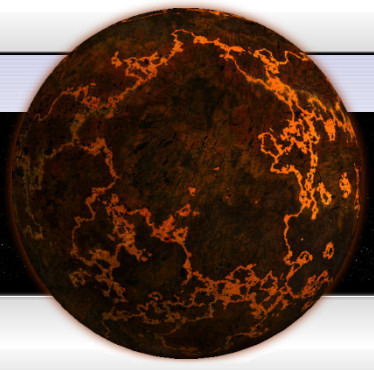
Class B
dwarf, geo-morteus
0-10 BYO, youngtight solar
1,000-10,000 km, small
~.005-.4 Earth masses
Hot
partially molten, highly unstable
N/A
extreme
450 / -200
N/A
~.1-.5 G
active volcanoes
usually very thin
helium, sodium
N/A
~.1-.25 atm
N/A
Yes
N/A
N/A
_ N/A
_
rusty mud and lava subtly and/or brightly glowing
Mercury (although it lacks volcanoes and is solid,
Char, Nebhilum (link Coming Soon).
---[Aspects]---
Terms:
Age:
Orbit:
Diameter:
Mass:
Solar System Zone:
Surface:
Composition:
Temperature:
Day / Night:
Light-side / Dark-side:
Gravity:
Tectonics:
Atmosphere:
Composition:
Density:
Pressure: (atm)
Core:
Hollow:
Composition:
Abundant / rich in:
Evolution:
Life:
Appearance:
From Space:
Examples:
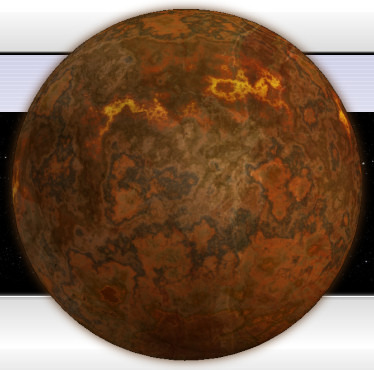
Class C
dwarf, geo-inactive
2-10 BYO, intermediatetight solar
1,000-10,000 km, small
~.005-.4 Earth masses
Ecosphere
barren
may be covered in ice and/or frozen gases
cold
N/A
N/A
~.2-.5 G
geologically inactive
none
N/A
N/A
0 atm
geologically inactive
Yes
N/A
N/A
_ N/A
_
sooty, lunaresque
Pluto, Psi 2000 (link Coming Soon).
---[Aspects]---
Terms:
Age:
Orbit:
Diameter:
Mass:
Solar System Zone:
Surface:
Composition:
Temperature:
Day / Night:
Light-side / Dark-side:
Gravity:
Tectonics:
Atmosphere:
Composition:
Density:
Pressure: (atm)
Core:
Hollow:
Composition:
Abundant / rich in:
Evolution:
Life:
Appearance:
From Space:
Examples:
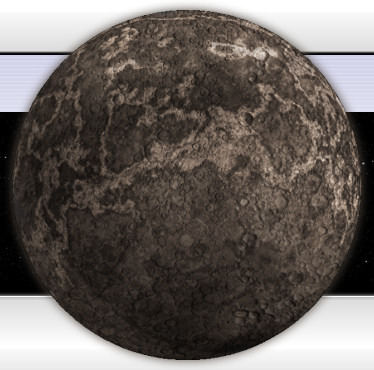
Class D
asteroid, moon, planetoid / dwarf, Plutonian object
2-10 BYO, intermediatevariable solar
100-4,000 km, tiny
~.001-.1 Earth masses
Hot / Ecosphere / Cold
barren, cratered
N/A
N/A
N/A
N/A
~.05 G
geologically inactive
none / very thin / tenuous
N/A
N/A
0-.1 atm
primarily ice; not a true 'planet'
Yes
_
primarily ice; not a true 'planet'
_ N/A
None
limestone covered, lunaresque
Ceres, Eredas-Il, Moon / Luna, Pluto / Plutonians.
---[Aspects]---
Terms:
Age:
Orbit:
Diameter:
Mass:
Solar System Zone:
Surface:
Composition:
Temperature:
Day / Night:
Light-side / Dark-side:
Gravity:
Tectonics:
Atmosphere:
Composition:
Density:
Pressure: (atm)
Core:
Hollow:
Composition:
Abundant / rich in:
Evolution:
Life:
Appearance:
From Space:
Examples:
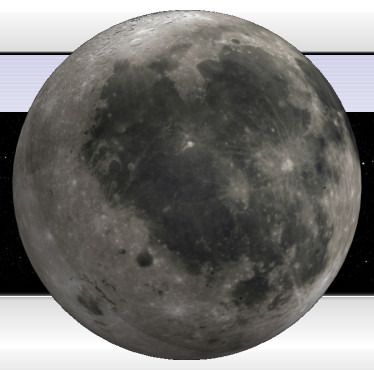
Superclass E-G
Class E
terrestrial, geo-plastic, proto-Earth
2-10 BYO, intermediatetight solar
10,000-15,000 km, small
~.4-2 Earth masses
Ecosphere
largely / completely molten, still forming
N/A
extremely hot
N/A
N/A
~1 G
volcanically active
thin to average
hydrogen compounds
N/A
~.25-1 atm
molten, makes susceptible to solar winds & radiation
Yes
N/A
N/A
cools (core and crust begin to harden) to Class F
Carbon cycle
mud and orange lava glowing
Excalbia (link Coming Soon)
---[Aspects]---
Terms:
Age:
Orbit:
Diameter:
Mass:
Solar System Zone:
Surface:
Composition:
Temperature:
Day / Night:
Light-side / Dark-side:
Gravity:
Tectonics:
Atmosphere:
Composition:
Density:
Pressure: (atm)
Core:
Hollow:
Composition:
Abundant / rich in:
Evolution:
Life:
Appearance:
From Space:
Examples:
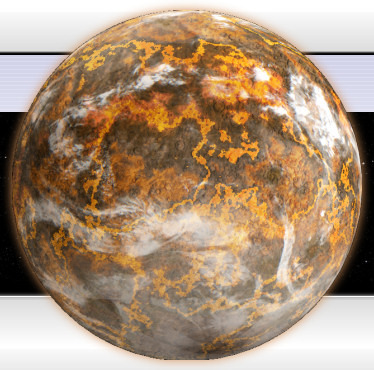
terrestrial, geo-metallic
1-3 BYO, youngtight solar
10,000-15,000 km, small
~.4-2 Earth masses
Ecosphere
barren
N/A
N/A
N/A
N/A
~1 G
active volcanoes
average
carbon dioxide, ammonia, methane
N/A
~1 atm
heavy metallic
Yes
N/A
ores, minerals
core cools and volcanic activity ceases to become Class G
bacteria
earth and moss tones
Janus IV (link Coming Soon)
Class F
---[Aspects]---
Terms:
Age:
Orbit:
Diameter:
Mass:
Solar System Zone:
Surface:
Composition:
Temperature:
Day / Night:
Light-side / Dark-side:
Gravity:
Tectonics:
Atmosphere:
Composition:
Density:
Pressure: (atm)
Core:
Hollow:
Composition:
Abundant / rich in:
Evolution:
Life:
Appearance:
From Space:
Examples:
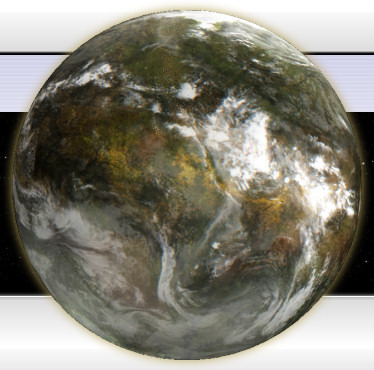
Class G
---[Aspects]---
Terms:
Age:
Orbit:
Diameter:
Mass:
Solar System Zone:
Surface:
Composition:
Temperature:
Day / Night:
Light-side / Dark-side:
Gravity:
Tectonics:
Atmosphere:
Composition:
Density:
Pressure: (atm)
Core:
Hollow:
Composition:
Abundant / rich in:
Evolution:
Life:
Appearance:
From Space:
Examples:
terrestrial, geo-crystalline
3-4 BYO, youngtight solar
10,000-15,000 km, small
~.4-2 Earth masses
Ecosphere
rocky, mostly barren, still solidifying
N/A
N/A
N/A
N/A
~1 G
_
average
carbon dioxide, oxygen, nitrogen
average
~1 atm
N/A
Yes
_
N/A
cools to become Classes: H, K, L, M, N, O, or P
vegetation, simple organisms
mud and forests
Delta Vega (link Coming Soon)
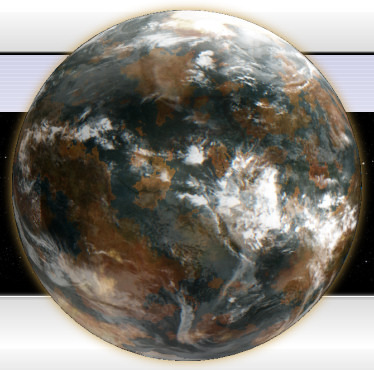
Class H
terrestrial, desert
4-10 BYO, intermediatetight solar
8,000-15,000 km, small
~.1-2 Earth masses
Ecosphere
barren, hot & arid (usually; if near-orbit) or icy tundra (distant orbit)
N/A
N/A
N/A
N/A
~.25-1 G
N/A
average
oxygen, nitrogen, argon, metals
average
~1 atm
N/A
Yes
N/A
N/A
_ N/A
drought-resistant plants / animals
varies
Dimovius, Nimbus III, Corneria, Ocampa (link Coming Soon).
---[Aspects]---
Terms:
Age:
Orbit:
Diameter:
Mass:
Solar System Zone:
Surface:
Composition:
Temperature:
Day / Night:
Light-side / Dark-side:
Gravity:
Tectonics:
Atmosphere:
Composition:
Density:
Pressure: (atm)
Core:
Hollow:
Composition:
Abundant / rich in:
Evolution:
Life:
Appearance:
From Space:
Examples:
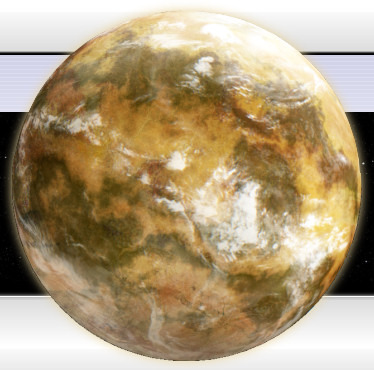
Superclass I-J,S-T
Class J
---[Aspects]---
Terms:
Age:
Orbit:
Diameter:
Mass:
Solar System Zone:
Surface:
Composition:
Temperature:
Day / Night:
Light-side / Dark-side:
Gravity:
Tectonics:
Atmosphere:
Composition:
Density:
Pressure: (atm)
Core:
Hollow:
Composition:
Abundant / rich in:
Evolution:
Life:
Appearance:
From Space:
Examples:
Jovian, gas-giant
2-10 BYO, intermediateaverage solar
50,000,000-85,000,000 km, large
14-17 Earth masses
Cold
liquid metallic hydrogen
hydrogen
N/A
N/A
N/A
~.9-1.2 G
N/A
quite thick
mainly hydrogen and helium
quite dense
>100 atm, extremely turbulent
possibly small, solid, rocky, or metallic hydrogen
Yes
hydrogen
N/A
_ N/A
avian, cetacean
hazy monochromatic
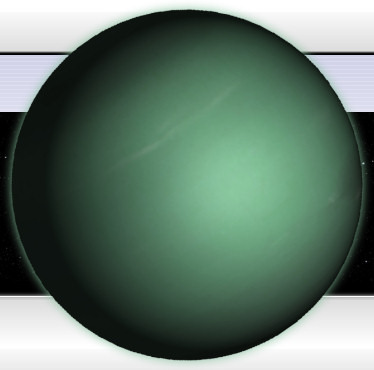
Jovian Subclasses
Class I: Ammonia Clouds
Orbit: outer solarsystem regions.
Temperature: <~150 kelvins(120 degrees Celsius/190 degrees Fahrenheit).
Appearance: dominated byammonia clouds.
Bond albedo: (around a Sun-like star) (link toSol / Ra) predicted to be 0.57, comparedwith a value of 0.343 for Jupiter and 0.342 for Saturn. The discrepancy can bepartially accounted for by taking into account non-equilibrium condensates suchas tholin orphosphorus, which are responsible for the colored clouds in the Jovianatmosphere, and are not modeled in the calculations.
Examples: Jupiter,Saturn.
Note: Thetemperature range requires a cool star or a distant perihelion for theplanet's orbit. The former stars might be toodim for us even to know about, and the latter orbits might be too unpronounced tonotice until several observations of those orbits' "years" (c.f.Kepler's Third Law).Super-Jovian planetswould have enough mass to improve these observations; but a super-Jovian ofcomparable age to Jupiter will have more internal heating than said planet,which could push it to a higher class.
Class II: Water Clouds
Temperature: too warm toform ammonia clouds.
Atmosphere: water vapor clouds.
Appear: more reflectivethan ammonia clouds.
Bond albedo: (around a Sun-like star) predicted:0.81. Even though the clouds on such a planetwould be similar to those of Earth, the atmosphere would still consist mainlyof hydrogen and hydrogen-rich molecules such as methane.
Examples: (possible)47 Ursae Majoris b,Upsilon Andromedae d.
Note: expected forplanets with temperatures >~250 K.
Class III: Cloudless
Orbit: inner solarsystem regions, ~ Mercury-orbit.
Atmosphere: equilibriumtemperatures between about 350 K (170 °F, 80 °C) and 800 K (980 °F, 530 °C) donot form global cloud cover, as they lack suitable chemicals in the atmosphereto form clouds.
Appear: featurelessblue globes because of Rayleigh and absorption by methane in their atmospheres, appearinglike Jovian-mass versions of Uranus and Neptune.
Bondalbedo: low; ~ 0.12 (arounda Sun-like star) due to absence of a reflective cloud layer.
Examples: Exo-planetsGliese 876 b, Upsilon Andromedae c.
Note: >700 K(800 °F, 430 °C), sulfides and chlorides might provide cirrus-like clouds.
Note: Planets ofclasses IV and V are referred to as hotJupiters.
Class IV: Alkali Metals
Temperature: >900 K (630°C/1160 °F).
Atmosphere: form cloud decksof silicates and iron deep/low, but this is not predicted to affect thespectrum of the planet.
Abundant:alkalimetals (such as sodium) substantiallyincrease, spectral lines of sodium and potassium predicted to be prominent.
Bondalbedo: (around a Sun-likestar) predicted:very low, at 0.03,because of the strong absorption by alkali metals.
Note: Carbon monoxidebecomes the dominant carbon-carrying molecule in the atmosphere (rather thanmethane).
Examples: 55Cancri b, HD 209458 b at 1300 K(1000 °C) with a geometric albedo of ~ 0 (zero).
Atmosphere: This star hostsan upper cloud deck absorbing so much heat that ha below it a relatively coolstratosphere.
Composition:(of thisdark cloud) assumed:titanium/vanadiumoxide (abbreviated "TiVO") by analogy with M Class dwarf stars.
Examples: HD 189733 b.
Temperature:920-1200K (650-930 °C).
Atmosphere: Nostratosphere has been conclusively proven yet.
Albedo: >0.14 (possiblydue to the brighter glow of its "hot spot").
Class V: Silicate Clouds
Temperatures:>1400 K(2100 °F, 1100 °C); hottest gas giants, or cooler planets with lower gravitythan Jupiter.
Atmosphere: silicate and ironcloud decks predicted to lie high.
Appear: may glow redfrom thermal radiation.
Bondalbedo: (around aSun-like star) predicted: 0.55 due toreflection by the cloud decks.
Examples: (possible)51 Pegasi b, HAT-P-11b, and thoseother gas giant exo-planets found by the Keplertelescope.
Note: For stars ofvisual magnitude <4.50 in Earth's sky, such planets are theoreticallyvisible to our instruments.
Orbit: outer solarsystem regions.
Temperature: <~150 kelvins(120 degrees Celsius/190 degrees Fahrenheit).
Appearance: dominated byammonia clouds.
Bond albedo: (around a Sun-like star) (link toSol / Ra) predicted to be 0.57, comparedwith a value of 0.343 for Jupiter and 0.342 for Saturn. The discrepancy can bepartially accounted for by taking into account non-equilibrium condensates suchas tholin orphosphorus, which are responsible for the colored clouds in the Jovianatmosphere, and are not modeled in the calculations.
Examples: Jupiter,Saturn.
Note: Thetemperature range requires a cool star or a distant perihelion for theplanet's orbit. The former stars might be toodim for us even to know about, and the latter orbits might be too unpronounced tonotice until several observations of those orbits' "years" (c.f.Kepler's Third Law).Super-Jovian planetswould have enough mass to improve these observations; but a super-Jovian ofcomparable age to Jupiter will have more internal heating than said planet,which could push it to a higher class.
Class II: Water Clouds
Temperature: too warm toform ammonia clouds.
Atmosphere: water vapor clouds.
Appear: more reflectivethan ammonia clouds.
Bond albedo: (around a Sun-like star) predicted:0.81. Even though the clouds on such a planetwould be similar to those of Earth, the atmosphere would still consist mainlyof hydrogen and hydrogen-rich molecules such as methane.
Examples: (possible)47 Ursae Majoris b,Upsilon Andromedae d.
Note: expected forplanets with temperatures >~250 K.
Class III: Cloudless
Orbit: inner solarsystem regions, ~ Mercury-orbit.
Atmosphere: equilibriumtemperatures between about 350 K (170 °F, 80 °C) and 800 K (980 °F, 530 °C) donot form global cloud cover, as they lack suitable chemicals in the atmosphereto form clouds.
Appear: featurelessblue globes because of Rayleigh and absorption by methane in their atmospheres, appearinglike Jovian-mass versions of Uranus and Neptune.
Bondalbedo: low; ~ 0.12 (arounda Sun-like star) due to absence of a reflective cloud layer.
Examples: Exo-planetsGliese 876 b, Upsilon Andromedae c.
Note: >700 K(800 °F, 430 °C), sulfides and chlorides might provide cirrus-like clouds.
Note: Planets ofclasses IV and V are referred to as hotJupiters.
Class IV: Alkali Metals
Temperature: >900 K (630°C/1160 °F).
Atmosphere: form cloud decksof silicates and iron deep/low, but this is not predicted to affect thespectrum of the planet.
Abundant:alkalimetals (such as sodium) substantiallyincrease, spectral lines of sodium and potassium predicted to be prominent.
Bondalbedo: (around a Sun-likestar) predicted:very low, at 0.03,because of the strong absorption by alkali metals.
Note: Carbon monoxidebecomes the dominant carbon-carrying molecule in the atmosphere (rather thanmethane).
Examples: 55Cancri b, HD 209458 b at 1300 K(1000 °C) with a geometric albedo of ~ 0 (zero).
Atmosphere: This star hostsan upper cloud deck absorbing so much heat that ha below it a relatively coolstratosphere.
Composition:(of thisdark cloud) assumed:titanium/vanadiumoxide (abbreviated "TiVO") by analogy with M Class dwarf stars.
Examples: HD 189733 b.
Temperature:920-1200K (650-930 °C).
Atmosphere: Nostratosphere has been conclusively proven yet.
Albedo: >0.14 (possiblydue to the brighter glow of its "hot spot").
Class V: Silicate Clouds
Temperatures:>1400 K(2100 °F, 1100 °C); hottest gas giants, or cooler planets with lower gravitythan Jupiter.
Atmosphere: silicate and ironcloud decks predicted to lie high.
Appear: may glow redfrom thermal radiation.
Bondalbedo: (around aSun-like star) predicted: 0.55 due toreflection by the cloud decks.
Examples: (possible)51 Pegasi b, HAT-P-11b, and thoseother gas giant exo-planets found by the Keplertelescope.
Note: For stars ofvisual magnitude <4.50 in Earth's sky, such planets are theoreticallyvisible to our instruments.
Class I
Jovian, super-giant
2-10 BYO, intermediate---[Aspects]---
Terms:
Age:
Orbit:
Diameter:
Mass:
Solar System Zone:
Surface:
Composition:
Temperature:
Day / Night:
Light-side / Dark-side:
Gravity:
Tectonics:
Atmosphere:
Composition:
Density:
Pressure: (atm)
Core:
Hollow:
Composition:
Abundant / rich in:
Evolution:
Life:
Appearance:
From Space:
Examples:
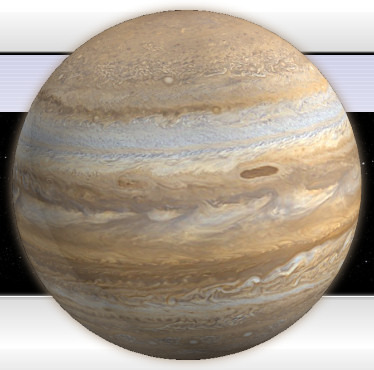
Class S
---[Aspects]---
Terms:
Age:
Orbit:
Diameter:
Mass:
Solar System Zone:
Surface:
Composition:
Temperature:
Day / Night:
Light-side / Dark-side:
Gravity:
Tectonics:
Atmosphere:
Composition:
Density:
Pressure: (atm)
Core:
Hollow:
Composition:
Abundant / rich in:
Evolution:
Life:
Appearance:
From Space:
Examples:
ultra-giant
2-10 BYO, intermediateaverage solar, 200 to 2000+ moons
120,000,000-380,000,000 km, very large
_-4,000 Earth masses
Cold
liquid metallic hydrogen
x
(radiate considerable heat)
N/A
N/A
1 G; generate enormous gravity
_
very thick
hydrogen, helium
very dense
# atm
liquid metallic hydrogen
Yes
_
carbide
_ N/A
_
polychromatic bands
Tethe-Alla IV (link Coming Soon).
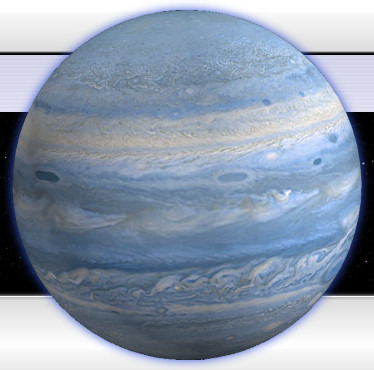
Class T
hyper-giant, brown-dwarf
2-10 BYO, intermediate_ solar
380,000,000-500,000,000 km, extremely large
- Jupiter masses; once 13+, ignites, making a binary system
Hot / Cold, most in Cold
_
x
N/A
N/A
N/A
1 G
_
extremely thick
liquid hydrogen, deuterium
extremely dense
# atm
_
Yes
_
_
becomes (star class) C
avian-cetacean transitioning into 'firies' (faery, angel, elemental); lifeforms will mutate/evolve to live here as this world ignites
_
Diadem, Tethe-Alla V (link Coming Soon).
---[Aspects]---
Terms:
Age:
Orbit:
Diameter:
Mass:
Solar System Zone:
Surface:
Composition:
Temperature:
Day / Night:
Light-side / Dark-side:
Gravity:
Tectonics:
Atmosphere:
Composition:
Density:
Pressure: (atm)
Core:
Hollow:
Composition:
Abundant / rich in:
Evolution:
Life:
Appearance:
From Space:
Examples:
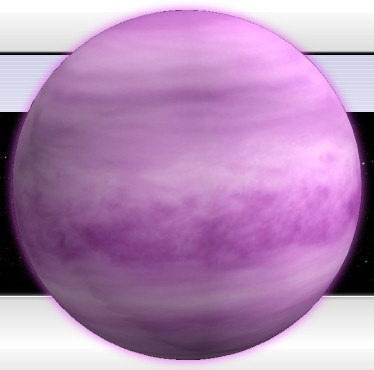
Class K
Ultra-giant
2-10 BYOtight solar
1,000-10,000 km
5-15 Earth masses
Hot / Ecosphere / Cold
Molten
x
500 / -200
N/A
_
1 G
_
thin
Helium
quite dense
# atm
Metallic
Yes / No
_
carbide
becomes C
None
reddish haze
Diadem, Pluto.
---[Aspects]---
Terms:
Age:
Orbit:
Diameter:
Mass:
Solar System Zone:
Surface:
Composition:
Temperature:
Day / Night:
Light-side / Dark-side:
Gravity:
Tectonics:
Atmosphere:
Composition:
Density:
Pressure: (atm)
Core:
Hollow:
Composition:
Abundant / rich in:
Evolution:
Life:
Appearance:
From Space:
Examples:
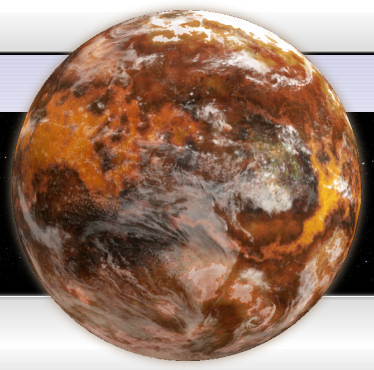
Class L
Ultra-giant
2-10 BYOtight solar
1,000-10,000 km
5-15 Earth masses
Hot / Ecosphere / Cold
Molten
x
500 / -200
N/A
_
1 G
_
thin
Helium
quite dense
# atm
Metallic
Yes / No
_
carbide
becomes C
None
reddish haze
Diadem, Pluto.
---[Aspects]---
Terms:
Age:
Orbit:
Diameter:
Mass:
Solar System Zone:
Surface:
Composition:
Temperature:
Day / Night:
Light-side / Dark-side:
Gravity:
Tectonics:
Atmosphere:
Composition:
Density:
Pressure: (atm)
Core:
Hollow:
Composition:
Abundant / rich in:
Evolution:
Life:
Appearance:
From Space:
Examples:
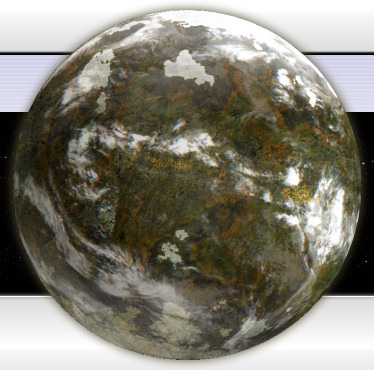
Ultra-giant
2-10 BYOtight solar
1,000-10,000 km
5-15 Earth masses
Hot / Ecosphere / Cold
Molten
x
500 / -200
N/A
_
1 G
_
thin
Helium
quite dense
# atm
Metallic
Yes / No
_
carbide
becomes C
None
reddish haze
Diadem, Pluto.
---[Aspects]---
Terms:
Age:
Orbit:
Diameter:
Mass:
Solar System Zone:
Surface:
Composition:
Temperature:
Day / Night:
Light-side / Dark-side:
Gravity:
Tectonics:
Atmosphere:
Composition:
Density:
Pressure: (atm)
Core:
Hollow:
Composition:
Abundant / rich in:
Evolution:
Life:
Appearance:
From Space:
Examples:
Class M
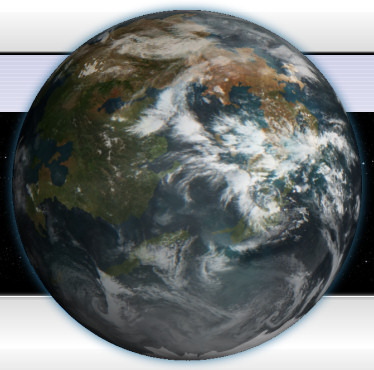
Class N
Ultra-giant
2-10 BYOtight solar
1,000-10,000 km
5-15 Earth masses
Hot / Ecosphere / Cold
Molten
x
500 / -200
N/A
_
1 G
_
thin
Helium
quite dense
# atm
Metallic
Yes / No
_
carbide
becomes C
None
reddish haze
Diadem, Pluto.
---[Aspects]---
Terms:
Age:
Orbit:
Diameter:
Mass:
Solar System Zone:
Surface:
Composition:
Temperature:
Day / Night:
Light-side / Dark-side:
Gravity:
Tectonics:
Atmosphere:
Composition:
Density:
Pressure: (atm)
Core:
Hollow:
Composition:
Abundant / rich in:
Evolution:
Life:
Appearance:
From Space:
Examples:
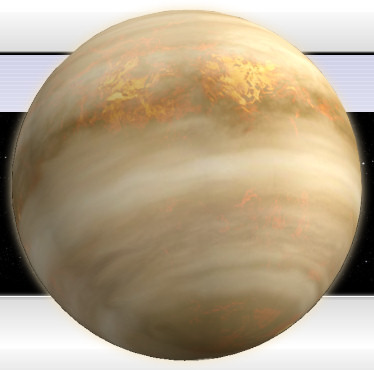
Superclass O-P
Class O
terrestrial
3-10 BYO, intermediatetight solar
10,000-15,000 km, small
_-_ Earth masses
Ecosphere
almost a global ocean
80% water
very warm
N/A
_
# G
_
average
nitrogen, oxygen, argon
average
# atm
_
Yes
_
_
becomes_ N/A
aquatic; cetacean, tropical vegetation, rare humanoids
blue tones
Azati Prime, Ka'Tula Prime, Zirat (link Coming Soon).
---[Aspects]---
Terms:
Age:
Orbit:
Diameter:
Mass:
Solar System Zone:
Surface:
Composition:
Temperature:
Day / Night:
Light-side / Dark-side:
Gravity:
Tectonics:
Atmosphere:
Composition:
Density:
Pressure: (atm)
Core:
Hollow:
Composition:
Abundant / rich in:
Evolution:
Life:
Appearance:
From Space:
Examples:
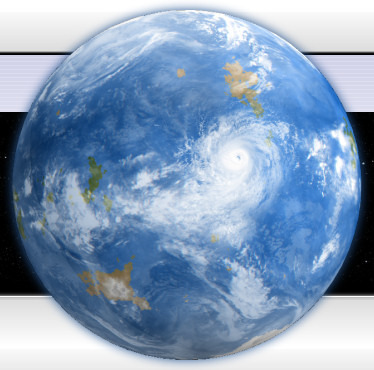
terrestrial
3-10 BYO, intermediatetight solar
10,000-15,000 km, small
_-1 Earth masses
Ecosphere
glaciated, abundant water
>80% frozen water ice
very cold
N/A
N/A
~1 G
_
average
nitrogen, oxygen
average
~-# atm
varies
Yes
varies
varies
becomes_ N/A
vegetation, animal, humanoid; usually adapted to frigid surface
shimmering whites
Callisto, Europa, Ganymede, Andoria, Exo III, Rebena Te Ra, Rura Penthe (link Coming Soon).
Class P
---[Aspects]---
Terms:
Age:
Orbit:
Diameter:
Mass:
Solar System Zone:
Surface:
Composition:
Temperature:
Day / Night:
Light-side / Dark-side:
Gravity:
Tectonics:
Atmosphere:
Composition:
Density:
Pressure: (atm)
Core:
Hollow:
Composition:
Abundant / rich in:
Evolution:
Life:
Appearance:
From Space:
Examples:
demon
2-10 BYO_
1,000-10,000 km, small
_-_ Earth masses
Hot
barren, conditions not of a recognizable category
possibly new/unknown elements
extremely hot
N/A
_
# G
_
none
N/A
N/A
0 atm
_
Yes
_
N/A
becomes_ C
None / bizarre; crystal, rock, liquid, gaseous, non-corporeal, dimensional, energy-based (i.e. Elementals)
N/A
Osiris (link Coming Soon)
Class X
Superclass X-Z
---[Aspects]---
Terms:
Age:
Orbit:
Diameter:
Mass:
Solar System Zone:
Surface:
Composition:
Temperature:
Day / Night:
Light-side / Dark-side:
Gravity:
Tectonics:
Atmosphere:
Composition:
Density:
Pressure: (atm)
Core:
Hollow:
Composition:
Abundant / rich in:
Evolution:
Life:
Appearance:
From Space:
Examples:
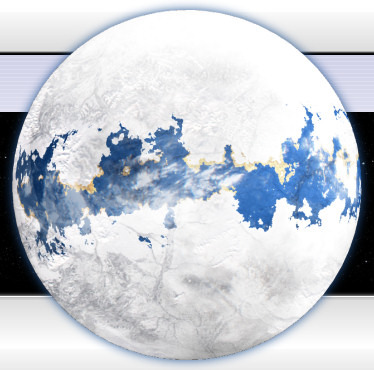
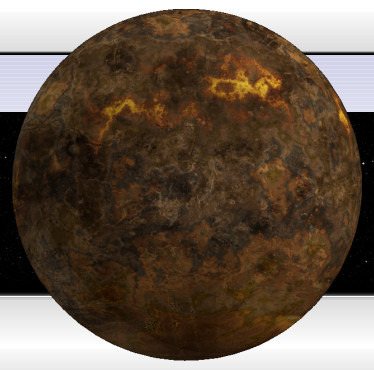
Class Q
Class Y
---[Aspects]---
Terms:
Age:
Orbit:
Diameter:
Mass:
Solar System Zone:
Surface:
Composition:
Temperature:
Day / Night:
Light-side / Dark-side:
Gravity:
Tectonics:
Atmosphere:
Composition:
Density:
Pressure: (atm)
Core:
Hollow:
Composition:
Abundant / rich in:
Evolution:
Life:
Appearance:
From Space:
Examples:
demon
10-15 BYOtight solar
1,000-10,000 km
5-15 Earth masses
Hot
conditions not of a recognizable category
x
extremely hot
N/A
N/A
# G
_
toxic radiation, turbulent; storms among most severe in galaxy
N/A
N/A
* winds: 500+ kph (310 mph / 270 knots)
Metallic
Yes
_
_
becomes_ C
Mimetic, bizarre: crystal, rock, liquid, gaseous, incorporeal, dimensional, energy-based (i.e. Elementals)
_
(planet) Hell
terrestrial
2-10 BYO, intermediatetight (around variable star) or eccentric solar
4,000-15,000 km, small
_-15 Earth masses
Hot / Ecosphere / Cold
molten and/or: frozen, jungle, varied
varies
varies
varies
varies
# G
varies
very tenuous to very dense
varies
varies
# atm
varies
Yes
varies
varies
becomes_ N/A
varies
varies
Genesis Planet (link Coming Soon)
---[Aspects]---
Terms:
Age:
Orbit:
Diameter:
Mass:
Solar System Zone:
Surface:
Composition:
Temperature:
Day / Night:
Light-side / Dark-side:
Gravity:
Tectonics:
Atmosphere:
Composition:
Density:
Pressure: (atm)
Core:
Hollow:
Composition:
Abundant / rich in:
Evolution:
Life:
Appearance:
From Space:
Examples:
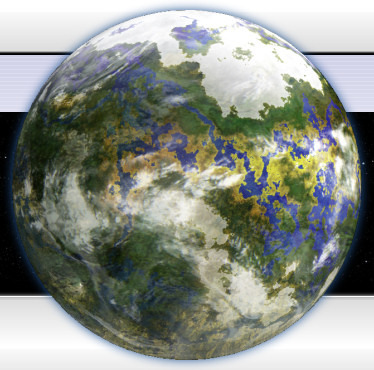
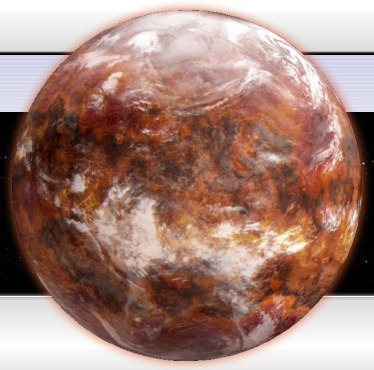
Class R
terrestrial, rogue
2-10 BYOtight solar
1,000-10,000 km
5-15 Earth masses
interstellar / deep space
usually barren
x
possibly temperate due to geothermal venting
N/A
_
# G
_
thin
primarily volcanic outgassing
varies
# atm
Metallic
Yes
_
_
becomes_ N/A
non-photosynthetic plants, animals, possible unusual life near volcanic regions, likely in darkness unless bioluminescent or in volcanic / artificial light
varies
Dakala, Veneihm, Founders' Homeworld (link Coming Soon).
Class Z
demon
_-_ BYO_
_,000-_,000 km
_-_ Earth masses
Hot / Ecosphere / Cold
_
x
_
N/A
N/A
# G
_
N/A
Helium
quite dense
# atm
_
Yes
_
_
becomes_ C
_
N/A
_
---[Aspects]---
Terms:
Age:
Orbit:
Diameter:
Mass:
Solar System Zone:
Surface:
Composition:
Temperature:
Day / Night:
Light-side / Dark-side:
Gravity:
Tectonics:
Atmosphere:
Composition:
Density:
Pressure: (atm)
Core:
Hollow:
Composition:
Abundant / rich in:
Evolution:
Life:
Appearance:
From Space:
Examples:
---[Aspects]---
Terms:
Age:
Orbit:
Diameter:
Mass:
Solar System Zone:
Surface:
Composition:
Temperature:
Day / Night:
Light-side / Dark-side:
Gravity:
Tectonics:
Atmosphere:
Composition:
Density:
Pressure: (atm)
Core:
Hollow:
Composition:
Abundant / rich in:
Evolution:
Life:
Appearance:
From Space:
Examples:
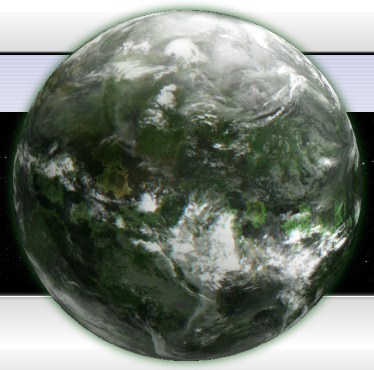
Planemo Group (ROGUES) Class R
orbit: not gravitationally bound to any star, depths ofinterstellar space.
Someformed naturally without a star,
othersgravitationally ejected from their home systems,
someroutinely traded between ejecting/collapsing/destabilizing systems.When teleportation and worm-holes are notoptions to relocate planets and stars, often sentient civilizations opt to maketheir planet habitable during long-term, slower transit/migration to availableorbit brackets in compatible star systems.
Hauhetean
primary atmospheres: hydrogen and helium,
mass: not great enough to maintain an internal geology.
Nyxian
Mass: not enough to retain primary hydrogen-heliumatmospheres.
Atmos:slips away
Some have asecondary atmosphere formed by volcanic outgassing, if they are massive enoughto maintain such activity.
Stevensonian
atmosphere dense traps heat from internal geological activity,which creates pockets of habitability on the surface.
Some are heated toan extent that entire surface may be habitable. –Summer is based onvolcanic-seasons/activity (when there is no tilt, wobble, or elliptical orbit)and the science of stimulating and regulating volcanoes is at artisan levels.
Kauketean
Atmosphere: dense enough to create scorching surface conditionsthrough trapped geothermal heat.
Mass: < Odyssian.
Odyssian massivehydrogen-helium envelopes. rogue gas giants.
orbit: not gravitationally bound to any star, depths ofinterstellar space.
Someformed naturally without a star,
othersgravitationally ejected from their home systems,
someroutinely traded between ejecting/collapsing/destabilizing systems.When teleportation and worm-holes are notoptions to relocate planets and stars, often sentient civilizations opt to maketheir planet habitable during long-term, slower transit/migration to availableorbit brackets in compatible star systems.
Hauhetean
primary atmospheres: hydrogen and helium,
mass: not great enough to maintain an internal geology.
Nyxian
Mass: not enough to retain primary hydrogen-heliumatmospheres.
Atmos:slips away
Some have asecondary atmosphere formed by volcanic outgassing, if they are massive enoughto maintain such activity.
Stevensonian
atmosphere dense traps heat from internal geological activity,which creates pockets of habitability on the surface.
Some are heated toan extent that entire surface may be habitable. –Summer is based onvolcanic-seasons/activity (when there is no tilt, wobble, or elliptical orbit)and the science of stimulating and regulating volcanoes is at artisan levels.
Kauketean
Atmosphere: dense enough to create scorching surface conditionsthrough trapped geothermal heat.
Mass: < Odyssian.
Odyssian massivehydrogen-helium envelopes. rogue gas giants.
Jovian Group (GAS GIANTS) J (giant), I (super-g), S (ultra-g), T(ultra-g to brn dwarf)
mass 10 to 4,000 Earth, ( 0.03 to 13 Jupiter).
Atmos: thick hydrogen and helium envelopes.
cores rock , ice, range from <1 Earth mass to 7.
Sub-Jovian
mass 10 to 4,000 Earth, ( 0.03 to 13 Jupiter).
Atmos: thick hydrogen and helium envelopes.
cores rock , ice, range from <1 Earth mass to 7.
Sub-Jovian
mass 0.03 - 0.48 Jupiter. Class I (Uranus, Neptune)
atmosphere typical dense , hydrogen and helium,
mass a large portion is ice and rock core. Some havecompressed liquid water oceanic mantle.
Sokarian
atmosphere typical dense , hydrogen and helium,
mass a large portion is ice and rock core. Some havecompressed liquid water oceanic mantle.
Sokarian
orbits tight solar
atmospheres upper largely filled with silicate clouds.Extreme examples may actually be too hot to support upper cloud layers.
Poseidonic,
atmospheres upper largely filled with silicate clouds.Extreme examples may actually be too hot to support upper cloud layers.
Poseidonic,
orbit within snow-line,
atmospheres large amounts of water vapor.
Neptunian,
atmospheres large amounts of water vapor.
Neptunian,
orbit beyond snow-line,
atmospheres often relatively quiet upper, overlain by amethane haze,
color blue to green.
Near upper atmospheric layers may be quite volatile, however, beingdriven more by the internal heat of the planet than by any solar energyreceived.
Dwarf-Jovian Class J (Saturn,Jupiter)
mass 0.06 - 0.8 Jupiter. The greatest portion oftheir masses are concentrated within their gaseous envelopes, but they stillhave a low enough gravity to swell from stellar heating. The more massiveexamples will have layers of liquid metallic hydrogen or helium surroundingtheir cores.
Osirian
atmospheres often relatively quiet upper, overlain by amethane haze,
color blue to green.
Near upper atmospheric layers may be quite volatile, however, beingdriven more by the internal heat of the planet than by any solar energyreceived.
Dwarf-Jovian Class J (Saturn,Jupiter)
mass 0.06 - 0.8 Jupiter. The greatest portion oftheir masses are concentrated within their gaseous envelopes, but they stillhave a low enough gravity to swell from stellar heating. The more massiveexamples will have layers of liquid metallic hydrogen or helium surroundingtheir cores.
Osirian
orbits tight solar,
atmospheres upper largely filled with silicate clouds.
Extreme examples mayactually be too hot to support uppercloud layers.
Brammian,
atmospheres upper largely filled with silicate clouds.
Extreme examples mayactually be too hot to support uppercloud layers.
Brammian,
orbit within snow-line,
atmospheres large amounts of water. Of all the Jovians in this orbitalregion, these are the most likely to developatmospheric-based life, although it rarely evolves past simple microbial forms.
Khonsonian,
atmospheres large amounts of water. Of all the Jovians in this orbitalregion, these are the most likely to developatmospheric-based life, although it rarely evolves past simple microbial forms.
Khonsonian,
orbit just outside snow-line,
atmospheres low instance of water. Upper is highlyaltered by the presence of ammonia-based life
ammonia-rich
Saturnian
atmospheres low instance of water. Upper is highlyaltered by the presence of ammonia-based life
ammonia-rich
Saturnian
orbit beyond snow-line,
atmospheres dynamic, often obscured by methane and ammonia.
Meso-Jovian Class S
mass 0.7 - 2.5 Jupiter. The greatest portion oftheir masses are concentrated within their gaseous envelopes, high cloudsurface gravities.
cores planet-sized surrounded by layers of metallicliquid hydrogen,
atmospheres dynamic, often obscured by methane and ammonia.
Meso-Jovian Class S
mass 0.7 - 2.5 Jupiter. The greatest portion oftheir masses are concentrated within their gaseous envelopes, high cloudsurface gravities.
cores planet-sized surrounded by layers of metallicliquid hydrogen,
composed of metals, carbon, and ices.
atmospheres almost always turbulent and lacking any haze layerof consequence.
Junic
atmospheres almost always turbulent and lacking any haze layerof consequence.
Junic
orbits tight solar,
atmospheres upper largely filled with silicate clouds.
Extreme examples maybe too hot to support uppercloud layers.
Jovic
atmospheres upper largely filled with silicate clouds.
Extreme examples maybe too hot to support uppercloud layers.
Jovic
orbit beyond snow-line,
atmospheres dynamic.
Super-Jovian Class T
mass: 2.5 - 13 Jupiter; enough mass to compress coresinto electron-degenerate matter. Despite their great masses, the sizes ofthese worlds rarely extend much beyond that of Jupiter; the notable exceptionsare those which experience atmospheric expansion from extreme solar heating.
Super-Junic
atmospheres dynamic.
Super-Jovian Class T
mass: 2.5 - 13 Jupiter; enough mass to compress coresinto electron-degenerate matter. Despite their great masses, the sizes ofthese worlds rarely extend much beyond that of Jupiter; the notable exceptionsare those which experience atmospheric expansion from extreme solar heating.
Super-Junic
orbits tight solar,
atmospheres upper largely filled with silicate clouds.
Extreme examples maybe too hot to support uppercloud layers.
Super-Jovic
atmospheres upper largely filled with silicate clouds.
Extreme examples maybe too hot to support uppercloud layers.
Super-Jovic
orbit beyond snow-line,
atmospheres dynamic.
Chthonian (no class?)
mass: 0.015 - 0.24 Jupiter.
exposed cores ofJovian worlds which lost their gaseous envelopes through solarevaporation. typically occurs to older Jovians in tight solar orbits, orthat have been greatly affected by the evolution of their primary star.
atmospheres dynamic.
Chthonian (no class?)
mass: 0.015 - 0.24 Jupiter.
exposed cores ofJovian worlds which lost their gaseous envelopes through solarevaporation. typically occurs to older Jovians in tight solar orbits, orthat have been greatly affected by the evolution of their primary star.
Helian Group (X Y Z)
mass3 to 17 Earth, enough to retain helium atmospheres.
Geo-Helian
mass 3 - 15 Earth, lack a layer of liquid orsuper-condensed volatiles, having either expended them long ago, or neverhaving had them to begin with.
Older, more stableregions may be heavily cratered, but much of the surface tendsto be geologically young.
Halcyonic
silicon-rich ,
orbits tight solar,
mass 5-15 Earth.
substantial surfacevolcanic activity,
y tho atmosphere is quite dense, it is relatively cloudless due tothe
extremely high temperatures.
surface /appear is thus visiblefrom space, but still partially obscured by the sheer thickness of theatmosphere, which from space appears as a blue haze, especially pronouncedalong the limb ofthe planet.
Hyperionic
silicate-rich ,
mass 5 - 13 Earth.
substantial surfacevolcanic activity, large greenhouse effect which is slightly off-set by a
cloudy atmosphere of yellowish sulfuric acid or water clouds.
surface extremely hot, well outside the range for life.
Thetusean
carbon-rich , tight solar orbits,
mass 5 - 15 Earth. substantial surface volcanicactivity,
atmosphere quite dense , thick with dark clouds of hydrocarbon soot.
surface extremely hot due to a combination of a very strong greenhouseeffect and the low albedo of the hydrocarbon clouds.
Metusean
Abundant : carbon
Mass: 4-13 Earth
Surface: substantial volcanic, extremely hot,well outside range for life
Liquid bodies:may be lakes/oceans of thick hydrocarbon tar
Atmosphere: large greenhouse effect offset by:
Cloudy
Appears Atmos of white water, brown ammoniumhydrosulfide, or cream-colored ammonia clouds.
Solarian
Abundant: carbide.
Orbit: tight solar.
Mass: 5-15 Earth
Temperature: extremely high/hot
Surface: substantial volcanic, visible from Space,partially obscured by sheer thickness of atmos
Liquid bodies:
Atmosphere: quite dense, relatively cloudless due toextremely high temperatures
From Space: appears as reddish haze (label ME2 worlds that looklike this!) esp pronounced along thelimb of the planet
Theanice-rich, mass 3 - 10 Earth, beyond snow-line.
Nebulous,
mass 3 - 15 Earth.
atmospheres extremely dense ,support a layer of super-condensed volatiles.
Geo-Nebulous
mass 5 - 15 Earth.
Temp extremely hot.
composed primarily of silicates, their thin crusts riddledwith tectonic activity.This activity may be of the degree that there areentire lakes or seas of magma. Within years, the surfaces can becompletely turned over.
atmospheres: thick , dense, supporting massive greenhouse effect andsometimes comprising up to 10% of the planet's mass.
Cryo-Nebulous
mass 4 - 10 Earth.
Orbit /form beyond the snow-line ,
composed of a roughly equal mixture of ice and rock.
Due to their mass their crusts are thin and riddled with cryo-volcanic activity, which serve to keep their surfaces fairly smooth.
atmospheresthick and dense, sometimes comprising up to 10% of theplanetary mass.
Panthalassic
mass 3 - 13 Earth.
aborted gas giants,having initially begun their formation beyond their solar system's snow-line. However, tidal dragging caused byinteractions with the accretiondisk causedthem to migrate inward of the snow-line, where their growth was slowed or halted due tothe sudden lack of abundant icy materials (which swiftly feed the growth of Jovian worlds). However,being composed of largely icy materials, they develop tremendously deep oceanicsurfaces and thickatmospheres of water, hydrogen, and oxygen.
mass3 to 17 Earth, enough to retain helium atmospheres.
Geo-Helian
mass 3 - 15 Earth, lack a layer of liquid orsuper-condensed volatiles, having either expended them long ago, or neverhaving had them to begin with.
Older, more stableregions may be heavily cratered, but much of the surface tendsto be geologically young.
Halcyonic
silicon-rich ,
orbits tight solar,
mass 5-15 Earth.
substantial surfacevolcanic activity,
y tho atmosphere is quite dense, it is relatively cloudless due tothe
extremely high temperatures.
surface /appear is thus visiblefrom space, but still partially obscured by the sheer thickness of theatmosphere, which from space appears as a blue haze, especially pronouncedalong the limb ofthe planet.
Hyperionic
silicate-rich ,
mass 5 - 13 Earth.
substantial surfacevolcanic activity, large greenhouse effect which is slightly off-set by a
cloudy atmosphere of yellowish sulfuric acid or water clouds.
surface extremely hot, well outside the range for life.
Thetusean
carbon-rich , tight solar orbits,
mass 5 - 15 Earth. substantial surface volcanicactivity,
atmosphere quite dense , thick with dark clouds of hydrocarbon soot.
surface extremely hot due to a combination of a very strong greenhouseeffect and the low albedo of the hydrocarbon clouds.
Metusean
Abundant : carbon
Mass: 4-13 Earth
Surface: substantial volcanic, extremely hot,well outside range for life
Liquid bodies:may be lakes/oceans of thick hydrocarbon tar
Atmosphere: large greenhouse effect offset by:
Cloudy
Appears Atmos of white water, brown ammoniumhydrosulfide, or cream-colored ammonia clouds.
Solarian
Abundant: carbide.
Orbit: tight solar.
Mass: 5-15 Earth
Temperature: extremely high/hot
Surface: substantial volcanic, visible from Space,partially obscured by sheer thickness of atmos
Liquid bodies:
Atmosphere: quite dense, relatively cloudless due toextremely high temperatures
From Space: appears as reddish haze (label ME2 worlds that looklike this!) esp pronounced along thelimb of the planet
Theanice-rich, mass 3 - 10 Earth, beyond snow-line.
Nebulous,
mass 3 - 15 Earth.
atmospheres extremely dense ,support a layer of super-condensed volatiles.
Geo-Nebulous
mass 5 - 15 Earth.
Temp extremely hot.
composed primarily of silicates, their thin crusts riddledwith tectonic activity.This activity may be of the degree that there areentire lakes or seas of magma. Within years, the surfaces can becompletely turned over.
atmospheres: thick , dense, supporting massive greenhouse effect andsometimes comprising up to 10% of the planet's mass.
Cryo-Nebulous
mass 4 - 10 Earth.
Orbit /form beyond the snow-line ,
composed of a roughly equal mixture of ice and rock.
Due to their mass their crusts are thin and riddled with cryo-volcanic activity, which serve to keep their surfaces fairly smooth.
atmospheresthick and dense, sometimes comprising up to 10% of theplanetary mass.
Panthalassic
mass 3 - 13 Earth.
aborted gas giants,having initially begun their formation beyond their solar system's snow-line. However, tidal dragging caused byinteractions with the accretiondisk causedthem to migrate inward of the snow-line, where their growth was slowed or halted due tothe sudden lack of abundant icy materials (which swiftly feed the growth of Jovian worlds). However,being composed of largely icy materials, they develop tremendously deep oceanicsurfaces and thickatmospheres of water, hydrogen, and oxygen.
Small Body Group
Mass: < 0.0001 Earth; not massive enough to sustain hydrostatic equilibrium.
Sizes: typically 3 meters to 20+ km across.
Vulcanoidal
Composition: rocky.
Mass: < 0.0001 Earth; not massive enough to sustain hydrostatic equilibrium.
Sizes: typically 3 meters to 20+ km across.
Vulcanoidal
Composition: rocky.
Orbit: epi-stellar.
Content: high metallic.
Note: Rare, even unique mineralogical properties may develop because of long term exposure (over 2+ billion years) to intense stellar radiation.
Asteroidal
Composition: archetypal asteroids.
Composition: archetypal asteroids.
Size: small, irregular bodies.
Orbit: often in specific belts / fields in a solar system, may be in eccentric solar orbits.
Metallic
Abundance / Rich in: metal.
Orbit: often in specific belts / fields in a solar system, may be in eccentric solar orbits.
Metallic
Abundance / Rich in: metal.
Composition: dense, 50+% metallic.
Note: In most systems, are least common asteroidal bodies.
Note: In most systems, are least common asteroidal bodies.
Silicaceous
Abundance / Rich in: silicate.
Abundance / Rich in: silicate.
Composition: 50+% silicate.
Note: fairly common inmost solar systems.
Note: fairly common inmost solar systems.
Carbonaceous
Abundance / Rich in: carbon.
Abundance / Rich in: carbon.
Composition: varying amounts of silicates and metals.
Note: by far the most common type of asteroidal in most systems.
Note: by far the most common type of asteroidal in most systems.
Gelidaceous
Abundance / Rich in: ice.
Abundance / Rich in: ice.
Composition: 50+% frozen volatiles.
Note: Unlike the Cometary Class, these are in stable, relatively circular orbits which do not take them close enough to the local star for volatile-loss.
Note: Unlike the Cometary Class, these are in stable, relatively circular orbits which do not take them close enough to the local star for volatile-loss.
Aggregate
Note: debris piles, held together by mutual gravity; forms may change over time, subtly or obviously, due to gravitational flexing.
Note: debris piles, held together by mutual gravity; forms may change over time, subtly or obviously, due to gravitational flexing.
Composition: may vary, but for the most part tend to be silicate-rich.
Cometary - comets,
Composition: 50+% ice.
Cometary - comets,
Composition: 50+% ice.
Orbit: can carry them relatively close to their star,causing volatile depletion and out-gassing.
Passive
Note: dormant.
Note: dormant.
Orbit: distant stellar, or are in the slow process of having them transformed to take them close to the stellar primary.
Oort
Orbit: outermost regions of their star's gravity well, typically: Oort cloud.
Orbit: outermost regions of their star's gravity well, typically: Oort cloud.
Note: nearly unchanged since their formation.
Kuiper
Orbit: Kuiper belt.
Note: remain relatively unchanged since the time of their formation.
Orbit: Kuiper belt.
Note: remain relatively unchanged since the time of their formation.
Centaur
Note: gravitationally ejected from Oortcloud /Kuiper belt, in outer planetary region of the system.
Note: gravitationally ejected from Oortcloud /Kuiper belt, in outer planetary region of the system.
Orbit: gravitationally unstable, will likely become ActiveType comets.
Active
Orbit: takes them fairly close to their stellar primary,resulting in volatile loss;
Orbit: takes them fairly close to their stellar primary,resulting in volatile loss;
classical comets.
Active-Brevis
Note: active bodies.
Active-Brevis
Note: active bodies.
Orbit: < 200 Earth years, gravitationally bound to their stellar primary, may be subject to shifting orbits over 200+million years.
Active-Dirunitus
Note: active bodies.
Active-Dirunitus
Note: active bodies.
Orbit: > 200 Earth years, gravitationally bound to the primary star.
Active-Effigia
Orbit: parabolic /hyperbolic; pass close to their/a star once, and are then flung out of the solar system forever.
Active-Effigia
Orbit: parabolic /hyperbolic; pass close to their/a star once, and are then flung out of the solar system forever.
Damocloid
Note: lost all of their volatiles.
Note: lost all of their volatiles.
Appear: quite similar to asteroids.
Age: typically quite ancient, although some are of average age, but have been trapped within very short-period orbits for most of their active lifetimes.
Age: typically quite ancient, although some are of average age, but have been trapped within very short-period orbits for most of their active lifetimes.
Tiny
Dwarf
Small
Medium
Large
very young
young
intermediate
old
ancient
Group
Class
Type
Sub-type
Sub-division
Barely
(dense/thick)
Quite
Very
Extremely
Detailed
Simple
Planet Classes
Metallicity
degrees kelvin (K)
tholin
perihelion
Kepler's 1st 2nd & Third Law
Super-Jovian
Bond Albedo
Rayleigh
cirrus clouds
hot Jupiters
spectral lines
alkali metals
stratosphere
exo-planets
Age:
Orbit:
Systems:
Mass:
Zone:
Surface:
Composition:
Temperature:
Tectonics / Geology:
Liquid bodies:
Atmosphere:
Core:
Abundant / rich in:
Appear:
Life:
Notes/ name origin: (added part only for those w it in their file/notes? -OR: for all names, to help understand roots...
Examples:
Dwarf Terrestrial Group (Corresponds to Classes: A B C D K)
Mass: 0.0001 - 0.15 Earth. Most massive enough tosustain hydrostatic equilibrium and support geological activity due totidal forces, although the lesser ex's are only roughly spherical and tendto be geologically quiescent.
Mass: 0.0001 - 0.15 Earth. Most massive enough tosustain hydrostatic equilibrium and support geological activity due totidal forces, although the lesser ex's are only roughly spherical and tendto be geologically quiescent.
Protothermic
- proto-planetary (Corresponds to Class B)
- still forming.
Surfaces: often partially to completely molten.
Atmospheres: typically thick with hydrogen and helium, as wellas gases released by the
- proto-planetary (Corresponds to Class B)
- still forming.
Surfaces: often partially to completely molten.
Atmospheres: typically thick with hydrogen and helium, as wellas gases released by the
massive geological activity; still suffer major impactevents.
In general, their ages are < between 10 and 100 myo. Prior tothis, they are still accreting mass at very highrate, and after this point the surface, though stilloccasionally experiencing major impacts, have largely cooled, forming the earliest crust.
Proto-Ferrinian (Corresponds to Classes: X/Z)
In general, their ages are < between 10 and 100 myo. Prior tothis, they are still accreting mass at very highrate, and after this point the surface, though stilloccasionally experiencing major impacts, have largely cooled, forming the earliest crust.
Proto-Ferrinian (Corresponds to Classes: X/Z)
Surfaces: extremely hot or even molten.
- very high metallic content, will eventually cool down into iron-rich bodies.
Typically found in orbit of high mass or high metal stars.
Proto-Lithian (Corresponds to Classes: X/Z)
- very high metallic content, will eventually cool down into iron-rich bodies.
Typically found in orbit of high mass or high metal stars.
Proto-Lithian (Corresponds to Classes: X/Z)
Surfaces: extremely hot or even molten.
Composed: primarily of silicates.
common in mostsystems.
Proto-Carbonic (Corresponds to Classes: X/Z)
Composed: primarily of silicates.
common in mostsystems.
Proto-Carbonic (Corresponds to Classes: X/Z)
Surfaces: extremely hot or even molten.
- carbon-rich, fairly common.
- tend to appear morein high-massed systems.
Proto-Gelidian
Surfaces: hot.
- high instances ofgeological activity.
- outer regions of asolar system.
- primary buildingmaterial is water.
May possesssignificant atmospheres and regions of liquid water ontheir surfaces.
As the world ages and cools, the atmosphere and liquid willfreeze out, while the heavier silicates and metals will have since sunk to formthe body's core.
Geo-Passive (Corresponds to Class C)
- do not sustaincontinuous or intermittent geological activity.
Surfaces: largely unchanged since the early period ofplanetary formation.
Ferrinian
- dormant
Composed: primarily of metals.
Most commonly found orbiting F-type and earlier stars, or in high metallicity systems.
Lithic
- dormant.
Composed: largely of silicates.
- common in all starsystems.
Janian
- tidally locked to their star.
Silicate rich.
Night-side: ice caps; the result of trapped volatiles eithernative to the world and coming from the now vanished primary atmosphere, or delivered via cometary impacts over the eons.
Hermian
hot.
silicate.
large metallic cores.
relatively thincrusts. Early catastrophic loss of mass through major impacts early inthe world's history are the typical cause for such geological configurations.
Vestian
Silicate-rich.
- ample evidence of ageologically active past, beyond the formation process.
- typically no atmosphere.
- quite common asmoons, or within inner solar system regions which experienced extensive tidaldisruption early in the system's history.
Selenian (Corresponds to Class C)
low metal.
Silicate-rich.
These are typically formed through the collision of twolarge bodies during the early formative period of a solar system. In suchcollisions, the higher massed world will absorb most of the heavy metals, whilethe lighter materials tend to aggregate into a separate body. As such,these worlds are most often found as moons around much larger bodies. They may alsoform normally within low metal systems. Those forming via collisions tendto have large amounts of evidence for a brief and active geological phase, theresult of the formation of the body and subsequent major impacts. Mature Selenian worlds, however, are almost completelygeologically inert, withonly the occasional outgassing of volatiles that have been working their way tothe surface for hundreds of millions of years. Such outgassing is verybrief and locally powerful, but makes little impact on the world ingeneral.
Atmospheres: either entirely absent, or transient due to variouscircumstances, such as major cometary impacts or extremely rare majoroutgassing events.
Cerean
low metal.
Silicate-rich.
- significant amountof volatiles, typically in subsurface deposits or geological layers.
Carbonian
dormant ,
largely composed of carbon, carbides, or hydrocarboncompounds.
Gelidian (Corresponds to Class D)
- dormant.
Composed: largely of ices.
Orbit: beyond the snow-line
Stygian
- survived themovement of their primary star off of the main sequence, and its subsequentevolution towards a stellar corpse.
Surfaces: show ample evidenceof transformation due to the primary's stellar evolution.
Geo-Thermic (Corresponds to Class Q)
- sustain regular orintermittent geological or geothermal activity due to temperature differences caused by highly eccentric orbits.
Phaethonic (Corresponds to Classes: X/Z)
Metal-rich.
- intense volcanism as they approach their parent star (orbit eccentric) at extreme epi-stellar distances.
Core: may not be geologically active,
Surface: is driving force behind the intermittent geologyas the crust continually melts and re-cools.
- named after Phaethonof Greek mythology, who drove his solar chariot too close to the Earth, scorchingit.
Apollonian X/Z
Silicate-rich.
intense volcanism as they approach their parent star (orbit eccentric) at extreme epi-stellar distances.
core may not be geologically active.
surface is the driving force behind the intermittentgeology as the crust continually melts and re-cools.
Sethian X/Z
carbon-rich.
experience intensehydrocarbon volcanism as they approach their parent star (orbit eccentric) at extreme epi-stellar distances.
core may not be geologically active.
surface is the driving force behind the intermittentgeology as the crust continually melts and re-cools.
named after Seth ofEgyptian mythology, who protected the sun god Ra during his nightly journeythrough the underworld.
Erisian
icy.
experience cryo-volcanism or crustal evaporation as they move in theirelliptical orbit to within the snow-line.
named after Eris,the Greek goddess of chaos, as well as the largest example of such a body inthe Sol /Ra System.
Geo-Tidal
continuousgeological activity due to tidal flexing. The level of activity can range from nearlyconstant resurfacing to regular cryo-volcanic outgassing.
Some are even ableto sustain clement environmentssuitable to the development of simple or complex life.
Hephaestian (CLASS E in StarTrek)
the most geologically active of planets.
surfaces almost entirely molten, and changeconstantly. entire planetary map can be changed within <1 yearStandard.
Hebean K?
Named after Hebe,the Greek goddess of youth
silicate-rich.
highly geologically active, large regions ofstability.
atmosphere thickness can vary, standing water typical onlyfor those larger-massed bodies that have a high level of activity and aresulting thick atmosphere.
average age of surface no more than 3 MYO,much like active Terrestrialworlds.
Promethean
silicate-rich, through a naturally balanced amount of tidalflexing, developed a full geological cycle similar to plate tectonics. Water oceans are a part of this process,
and life, even advanced multi-cellular biomes, can befound.
Appear: From the surface, or from orbit, indistinguishablefrom the Gaianworlds.However, the processes which keep them habitable are far different.
Eo-Promethean
Age: roughly 800 MYO - 3 BYO,
relatively warm and wet alkaline environment,
thick atmosphere rich in carbon dioxideand methane, along with a hydrocarbon haze..
The first oceansformed during the earliest part of this period, as will have the earliest formsof life.
Meso-Promethean
Age: roughly 3 - 4 BYO,
a relatively warm and wet alkaline environment,
thickatmosphere has little / no methane, but which remains thickwith carbon dioxide.
Single-celled simplelife forms remain dominant, although towards the end ofthis period the first multi-cellular forms will typically begin toappear. Also towards the end of this phase, these life forms willtypically begin to infuse large amounts of oxygen into the atmosphere, transforming the entire biosphere.
Eu-Promethean
can be characterizedas being "mature", in that their biosphere is fullyformed. life has come to fill nearly every ecological nichepossible.
rich nitrogen-oxygenatmosphere,
remain geologically active, distinct divisions betweenterrestrial and oceanic crusts.
Bathy-Promethean
formed with a largeamount of water, the result being that nearly the entire surface if covered by deep oceans.
geological: cycle continues normally, however, with theoccasional volcanic island or micro-continent being formed before the oceanerodes it away, within only a few tens of millions of years.
Amu-Promethean
mature,
but they orbit at a further distance from their star than other Promethean worlds,
and have ammonia asa part of their biosphere. oceans are heavily infused with ammonia,life forms are reliant upon it as a part of their biochemical makeup.
the presence of thisammonia allows the surface water to remain unfrozen.
Thio-Promethean
mature,
orbit furthest distance possible from their star andremain biologically viable. This is due to thepresence of large amounts of methane, from the oceans to the life forms present.
because of the low temperatures, life may not developinto complex forms for billions of years, possibly taking longer than the mainsequence lifespan of their star.
Lokian
the most active of carbon planets,
surfaces almost entirely molten, a geology which changes onan almost yearly basis.
carbon-analogues to Hephaestian worlds.
Idunnian
Named after Idunn,the Norse goddess of youth,
carbon-rich ,
highly geologically active,possess large regions of stabilityas well.
atmosphere can vary in thickness, with standing liquidammonia typical only for those larger-massed bodies which have a high level ofactivity and thus thicker atmospheres.
average age of the surface is no more than 3MYO.
carbon analogues to Hebean Type worlds.
Burian
carbon-rich,
through a naturallybalanced amount of tidal flexing, have developed a geological cycle similar to plate tectonics.
Ammonia oceans, life, and even advanced biomes can occur,
Appear from the surface they are almost indistinguishablefrom AmunianType worlds, thoughthe processes which keep them habitable are quite different.
often considered tobe the carbon equivalent of Promethean worlds.
Temp Liquid water not possible, even when mixed withammonia; water ice does occur, and is typically rock-hard, forming the bulk ofthe crust and mantle.
Atlan
icy,
through a naturallybalanced amount of tidal flexing, has developed a cryo-geological cycle similar to plate tectonics.
Methane oceans,methane-based life, and even advanced biomes can occur.
surface : almost indistinguishable (appear) from Tartarian Type planets, but the processeswhich keep them habitable are far different.
consideredmethane-equivalents to Prometheanworlds.
Temp Liquid water not possible beyond thermal regions,even when mixed with methane, and instead occurs as granite-hard deposits,forming the bulk of the crust and mantle.
Plutonian Class C
tidally stretched,
icy,
varying degrees of cryo-volcanic and other forms of geological activity
orbit outer regions of solar systems, typically as moonsto Jovianworlds,although independent bodies (R, Q, X, Z) may arise.
Europan
tidally stretched tothe point of forming subsurface oceans,which can range from being a thin slushy layer <1 km thick, to great liquid water oceans 200+ km deep.
surface covered with icy crusts, often exhibitingdeformations indicative of the oceans below.
Enceladusian,
icy,
surfaces smooth and relatively crater free due tooutgassing of volatiles from subsurface reservoirs. Surface ridges andgrooves cover much of the slowly dynamic surface, although there are morestable, cratered regions as well. The reservoirs themselves exist asisolated pockets of semi-liquid water, maintained as such by the slow tidalflexing.
the tidal flexingwhich creates these worlds is of a type far less powerful than that whichcreates Europanworlds.
Iapetean,
icy,
rich in carbon materials, which are marked by extensiveup-wellings of hydrocarbons.
surfaces typically quite splotchy as the ice contrasts with the extremely dark hydrocarbonsediments. Major rift zones and upwelling regions are also formed by thisactivity, built up into tremendouslytall ridges and mountains by thedeposition of the heavier materials.
Tritonic,
icy ,
marked by cryo-volcanic outgassing, although most of the surface isgeologically stable.
atmosphere varies in thickness, but typically is quite thin,if present.
Standing bodies ofliquid methane are possible, although rare, typically being present only nearcryo-thermal regions, and when the atmosphere is thick.
Geo-Cyclic
active geology that occurs on a cyclic basis, often over a spanof 200+ million years. driving force behind this cycle tends to be a slowbuild-up of geothermal energy, resulting in a short active phase following along quiescent phase. Other mechanisms may also be responsible.
Arean dfntly Class K
silicate-rich ,
typically relatively quiescent planetary cores.
atmospheres range from thick and volatile-laden to almostvanishingly thin.
Age In youth : may have begun a system of plate tectonics, but the lack of a permanent presence of liquidwater on the surface quickly arrested that, leaving the surface barren.
The slow build up ofgeological energy, however, will eventually lead to much more clementconditions, and may harbor the development of simple life, or even more complex forms if there is enoughtime.This movement from cold and dry to warm and wet conditions is called aSisyphean Cycle, andcan conceivably bemaintained for billions of years.
Meso-Arean,
intermittent geological activity, periods of freezing and thawing, massiveand sudden floods and the growth of glaciers and ice caps. They representthe rise to and fall from the height of geological activity in the Sisyphean Cycle.
Eu-Arean,
the quiescent, cold, and dry phase of the Sisyphean Cycle.
surfaces barren and accumulated large number of impactcraters,
atmospheres largely eroded away to only a thin covering ofcarbon dioxide.
may be some residualgeological activity,
and even pockets ofextremophile life, typically deep beneath the surface, but for themost part these worlds can be considered to be "dead".
Arean-Lacustric,
the height of their Sisyphean Cycle,wet and clement surfaces.
Simple life is abundant, and on those more massive worldswhere this phase lasts longer, more complex forms might develop.
atmospherethick with carbondioxide, powered by the extensive geological activity.
Temp At its height, may be too warm for polar caps.
Utgardian
carbon-rich ,
relatively quiescentcores ,
surfaces: ammonia-rich.
atmospheres range from thick to only moderately so, neverbecoming exceedingly thin due to the distances (orbit) ofsuch worlds from their primary star, and the ease which coldtemperatures retain atmosphericgases.
slow build-up of geological activity brings these worlds from relatively dryconditions to a state where the surface is marked with liquid ammonia seas,rivers, and possibly even ammonia-based life.This Ragnarokian Cycle alternates over tensof millions of years, sometimes hundreds of millions, and it could last forbillions of years.
Meso-Utgardian,
intermittent geological activity,
surfaces either slowly drying out, or marked by the thawingof ammonia reserves. They mark the rise and fall from the height of thisactivity cycle, and thus can have dynamic surfaces.
Eu-Utgardian,
quiescent and dry phase of the Ragnarokian Cycle.
surfaces barren, and thelack of activity lends towards the accumulation of impact craters. becomesdominated by Aeolian forces
atmospheres thinned somewhat due to the lack of surfaceactivity,
but because of the coldtemperatures typical for their orbital position, they still remain thicker than normal,
and are rich in methane.
Any advanced life that had previously managed to evolve will goextinct, although the more primitive and hardy microscopic forms will remain,typically deep beneath the surface.
Utgardi-Lacustric,
the height of theiractivity cycle,
resplendent with seas and evenoceans of liquid ammonia.
atmospheres quite thick,
environment is warm, relatively speaking.
Life, largely dormant before hand, will expand acrossthe surface, and given enough time may even diversify intomore advanced multi-cellular forms. This phase of the cycle may last tensof millions of years, or more, largely depending on world mass and the amountsof heavy metals present.
Titanian
carbon-rich ,
relatively quiescentcores ,
surfaces methane-rich.
atmospheres, because it is so cold and the gases soeasily retained in their distant orbital positions, arealmost always thick with methane andhydrocarbons. greenhouse effect caused by methane is present, but largelynegligible due to the distance from the parent star. Over time, andbecause of the lack of heavy geological activity, the atmosphere may slowly diminish, turning the world into a frozen body over thecourse of 7+ billion years. Only renewed activity will reform thegreenhouse environment, and the seas will again thaw.This Titano-malchianCyclealternates over 20+ million years, sometimes 200+million, and could last for 2+ billion years.
Meso-Titanian,
intermittent geological and cryo-volcanic activity,
surfaces either drying out and freezing, or marked by the thawing of methanereserves. These worlds mark the rise and fall from the height of this cycle,surfaces have potential for being quite dynamic.
Eu-Titanian,
quiescent and dry phase of the Titano-malchian Cycle.
surfaces are barren, and thelack of activity lends itself towards the accumulation of impact craters.become dominated by Aeolian forces
atmospheres will become less dynamic during this phase, butwill experience relatively little loss of mass overall.
Any advanced life that had managed to evolve during the active phasewill likely go extinct, leaving only the hardier extremophile forms.
Titani-Lacustric,
the height of theiractivity cycle,
resplendent with seas and evenoceans of liquid methane.
atmospheres quite thick with extensive hydrocarbon hazes,
environment is warm, relatively speaking.
Life has potential for developing into complex forms,but because of the cold environment, thisis not very common. This phase of the cycle may last 20+ million years,or more, largely depending on world mass and the amounts of heavy metalspresent.
- carbon-rich, fairly common.
- tend to appear morein high-massed systems.
Proto-Gelidian
Surfaces: hot.
- high instances ofgeological activity.
- outer regions of asolar system.
- primary buildingmaterial is water.
May possesssignificant atmospheres and regions of liquid water ontheir surfaces.
As the world ages and cools, the atmosphere and liquid willfreeze out, while the heavier silicates and metals will have since sunk to formthe body's core.
Geo-Passive (Corresponds to Class C)
- do not sustaincontinuous or intermittent geological activity.
Surfaces: largely unchanged since the early period ofplanetary formation.
Ferrinian
- dormant
Composed: primarily of metals.
Most commonly found orbiting F-type and earlier stars, or in high metallicity systems.
Lithic
- dormant.
Composed: largely of silicates.
- common in all starsystems.
Janian
- tidally locked to their star.
Silicate rich.
Night-side: ice caps; the result of trapped volatiles eithernative to the world and coming from the now vanished primary atmosphere, or delivered via cometary impacts over the eons.
Hermian
hot.
silicate.
large metallic cores.
relatively thincrusts. Early catastrophic loss of mass through major impacts early inthe world's history are the typical cause for such geological configurations.
Vestian
Silicate-rich.
- ample evidence of ageologically active past, beyond the formation process.
- typically no atmosphere.
- quite common asmoons, or within inner solar system regions which experienced extensive tidaldisruption early in the system's history.
Selenian (Corresponds to Class C)
low metal.
Silicate-rich.
These are typically formed through the collision of twolarge bodies during the early formative period of a solar system. In suchcollisions, the higher massed world will absorb most of the heavy metals, whilethe lighter materials tend to aggregate into a separate body. As such,these worlds are most often found as moons around much larger bodies. They may alsoform normally within low metal systems. Those forming via collisions tendto have large amounts of evidence for a brief and active geological phase, theresult of the formation of the body and subsequent major impacts. Mature Selenian worlds, however, are almost completelygeologically inert, withonly the occasional outgassing of volatiles that have been working their way tothe surface for hundreds of millions of years. Such outgassing is verybrief and locally powerful, but makes little impact on the world ingeneral.
Atmospheres: either entirely absent, or transient due to variouscircumstances, such as major cometary impacts or extremely rare majoroutgassing events.
Cerean
low metal.
Silicate-rich.
- significant amountof volatiles, typically in subsurface deposits or geological layers.
Carbonian
dormant ,
largely composed of carbon, carbides, or hydrocarboncompounds.
Gelidian (Corresponds to Class D)
- dormant.
Composed: largely of ices.
Orbit: beyond the snow-line
Stygian
- survived themovement of their primary star off of the main sequence, and its subsequentevolution towards a stellar corpse.
Surfaces: show ample evidenceof transformation due to the primary's stellar evolution.
Geo-Thermic (Corresponds to Class Q)
- sustain regular orintermittent geological or geothermal activity due to temperature differences caused by highly eccentric orbits.
Phaethonic (Corresponds to Classes: X/Z)
Metal-rich.
- intense volcanism as they approach their parent star (orbit eccentric) at extreme epi-stellar distances.
Core: may not be geologically active,
Surface: is driving force behind the intermittent geologyas the crust continually melts and re-cools.
- named after Phaethonof Greek mythology, who drove his solar chariot too close to the Earth, scorchingit.
Apollonian X/Z
Silicate-rich.
intense volcanism as they approach their parent star (orbit eccentric) at extreme epi-stellar distances.
core may not be geologically active.
surface is the driving force behind the intermittentgeology as the crust continually melts and re-cools.
Sethian X/Z
carbon-rich.
experience intensehydrocarbon volcanism as they approach their parent star (orbit eccentric) at extreme epi-stellar distances.
core may not be geologically active.
surface is the driving force behind the intermittentgeology as the crust continually melts and re-cools.
named after Seth ofEgyptian mythology, who protected the sun god Ra during his nightly journeythrough the underworld.
Erisian
icy.
experience cryo-volcanism or crustal evaporation as they move in theirelliptical orbit to within the snow-line.
named after Eris,the Greek goddess of chaos, as well as the largest example of such a body inthe Sol /Ra System.
Geo-Tidal
continuousgeological activity due to tidal flexing. The level of activity can range from nearlyconstant resurfacing to regular cryo-volcanic outgassing.
Some are even ableto sustain clement environmentssuitable to the development of simple or complex life.
Hephaestian (CLASS E in StarTrek)
the most geologically active of planets.
surfaces almost entirely molten, and changeconstantly. entire planetary map can be changed within <1 yearStandard.
Hebean K?
Named after Hebe,the Greek goddess of youth
silicate-rich.
highly geologically active, large regions ofstability.
atmosphere thickness can vary, standing water typical onlyfor those larger-massed bodies that have a high level of activity and aresulting thick atmosphere.
average age of surface no more than 3 MYO,much like active Terrestrialworlds.
Promethean
silicate-rich, through a naturally balanced amount of tidalflexing, developed a full geological cycle similar to plate tectonics. Water oceans are a part of this process,
and life, even advanced multi-cellular biomes, can befound.
Appear: From the surface, or from orbit, indistinguishablefrom the Gaianworlds.However, the processes which keep them habitable are far different.
Eo-Promethean
Age: roughly 800 MYO - 3 BYO,
relatively warm and wet alkaline environment,
thick atmosphere rich in carbon dioxideand methane, along with a hydrocarbon haze..
The first oceansformed during the earliest part of this period, as will have the earliest formsof life.
Meso-Promethean
Age: roughly 3 - 4 BYO,
a relatively warm and wet alkaline environment,
thickatmosphere has little / no methane, but which remains thickwith carbon dioxide.
Single-celled simplelife forms remain dominant, although towards the end ofthis period the first multi-cellular forms will typically begin toappear. Also towards the end of this phase, these life forms willtypically begin to infuse large amounts of oxygen into the atmosphere, transforming the entire biosphere.
Eu-Promethean
can be characterizedas being "mature", in that their biosphere is fullyformed. life has come to fill nearly every ecological nichepossible.
rich nitrogen-oxygenatmosphere,
remain geologically active, distinct divisions betweenterrestrial and oceanic crusts.
Bathy-Promethean
formed with a largeamount of water, the result being that nearly the entire surface if covered by deep oceans.
geological: cycle continues normally, however, with theoccasional volcanic island or micro-continent being formed before the oceanerodes it away, within only a few tens of millions of years.
Amu-Promethean
mature,
but they orbit at a further distance from their star than other Promethean worlds,
and have ammonia asa part of their biosphere. oceans are heavily infused with ammonia,life forms are reliant upon it as a part of their biochemical makeup.
the presence of thisammonia allows the surface water to remain unfrozen.
Thio-Promethean
mature,
orbit furthest distance possible from their star andremain biologically viable. This is due to thepresence of large amounts of methane, from the oceans to the life forms present.
because of the low temperatures, life may not developinto complex forms for billions of years, possibly taking longer than the mainsequence lifespan of their star.
Lokian
the most active of carbon planets,
surfaces almost entirely molten, a geology which changes onan almost yearly basis.
carbon-analogues to Hephaestian worlds.
Idunnian
Named after Idunn,the Norse goddess of youth,
carbon-rich ,
highly geologically active,possess large regions of stabilityas well.
atmosphere can vary in thickness, with standing liquidammonia typical only for those larger-massed bodies which have a high level ofactivity and thus thicker atmospheres.
average age of the surface is no more than 3MYO.
carbon analogues to Hebean Type worlds.
Burian
carbon-rich,
through a naturallybalanced amount of tidal flexing, have developed a geological cycle similar to plate tectonics.
Ammonia oceans, life, and even advanced biomes can occur,
Appear from the surface they are almost indistinguishablefrom AmunianType worlds, thoughthe processes which keep them habitable are quite different.
often considered tobe the carbon equivalent of Promethean worlds.
Temp Liquid water not possible, even when mixed withammonia; water ice does occur, and is typically rock-hard, forming the bulk ofthe crust and mantle.
Atlan
icy,
through a naturallybalanced amount of tidal flexing, has developed a cryo-geological cycle similar to plate tectonics.
Methane oceans,methane-based life, and even advanced biomes can occur.
surface : almost indistinguishable (appear) from Tartarian Type planets, but the processeswhich keep them habitable are far different.
consideredmethane-equivalents to Prometheanworlds.
Temp Liquid water not possible beyond thermal regions,even when mixed with methane, and instead occurs as granite-hard deposits,forming the bulk of the crust and mantle.
Plutonian Class C
tidally stretched,
icy,
varying degrees of cryo-volcanic and other forms of geological activity
orbit outer regions of solar systems, typically as moonsto Jovianworlds,although independent bodies (R, Q, X, Z) may arise.
Europan
tidally stretched tothe point of forming subsurface oceans,which can range from being a thin slushy layer <1 km thick, to great liquid water oceans 200+ km deep.
surface covered with icy crusts, often exhibitingdeformations indicative of the oceans below.
Enceladusian,
icy,
surfaces smooth and relatively crater free due tooutgassing of volatiles from subsurface reservoirs. Surface ridges andgrooves cover much of the slowly dynamic surface, although there are morestable, cratered regions as well. The reservoirs themselves exist asisolated pockets of semi-liquid water, maintained as such by the slow tidalflexing.
the tidal flexingwhich creates these worlds is of a type far less powerful than that whichcreates Europanworlds.
Iapetean,
icy,
rich in carbon materials, which are marked by extensiveup-wellings of hydrocarbons.
surfaces typically quite splotchy as the ice contrasts with the extremely dark hydrocarbonsediments. Major rift zones and upwelling regions are also formed by thisactivity, built up into tremendouslytall ridges and mountains by thedeposition of the heavier materials.
Tritonic,
icy ,
marked by cryo-volcanic outgassing, although most of the surface isgeologically stable.
atmosphere varies in thickness, but typically is quite thin,if present.
Standing bodies ofliquid methane are possible, although rare, typically being present only nearcryo-thermal regions, and when the atmosphere is thick.
Geo-Cyclic
active geology that occurs on a cyclic basis, often over a spanof 200+ million years. driving force behind this cycle tends to be a slowbuild-up of geothermal energy, resulting in a short active phase following along quiescent phase. Other mechanisms may also be responsible.
Arean dfntly Class K
silicate-rich ,
typically relatively quiescent planetary cores.
atmospheres range from thick and volatile-laden to almostvanishingly thin.
Age In youth : may have begun a system of plate tectonics, but the lack of a permanent presence of liquidwater on the surface quickly arrested that, leaving the surface barren.
The slow build up ofgeological energy, however, will eventually lead to much more clementconditions, and may harbor the development of simple life, or even more complex forms if there is enoughtime.This movement from cold and dry to warm and wet conditions is called aSisyphean Cycle, andcan conceivably bemaintained for billions of years.
Meso-Arean,
intermittent geological activity, periods of freezing and thawing, massiveand sudden floods and the growth of glaciers and ice caps. They representthe rise to and fall from the height of geological activity in the Sisyphean Cycle.
Eu-Arean,
the quiescent, cold, and dry phase of the Sisyphean Cycle.
surfaces barren and accumulated large number of impactcraters,
atmospheres largely eroded away to only a thin covering ofcarbon dioxide.
may be some residualgeological activity,
and even pockets ofextremophile life, typically deep beneath the surface, but for themost part these worlds can be considered to be "dead".
Arean-Lacustric,
the height of their Sisyphean Cycle,wet and clement surfaces.
Simple life is abundant, and on those more massive worldswhere this phase lasts longer, more complex forms might develop.
atmospherethick with carbondioxide, powered by the extensive geological activity.
Temp At its height, may be too warm for polar caps.
Utgardian
carbon-rich ,
relatively quiescentcores ,
surfaces: ammonia-rich.
atmospheres range from thick to only moderately so, neverbecoming exceedingly thin due to the distances (orbit) ofsuch worlds from their primary star, and the ease which coldtemperatures retain atmosphericgases.
slow build-up of geological activity brings these worlds from relatively dryconditions to a state where the surface is marked with liquid ammonia seas,rivers, and possibly even ammonia-based life.This Ragnarokian Cycle alternates over tensof millions of years, sometimes hundreds of millions, and it could last forbillions of years.
Meso-Utgardian,
intermittent geological activity,
surfaces either slowly drying out, or marked by the thawingof ammonia reserves. They mark the rise and fall from the height of thisactivity cycle, and thus can have dynamic surfaces.
Eu-Utgardian,
quiescent and dry phase of the Ragnarokian Cycle.
surfaces barren, and thelack of activity lends towards the accumulation of impact craters. becomesdominated by Aeolian forces
atmospheres thinned somewhat due to the lack of surfaceactivity,
but because of the coldtemperatures typical for their orbital position, they still remain thicker than normal,
and are rich in methane.
Any advanced life that had previously managed to evolve will goextinct, although the more primitive and hardy microscopic forms will remain,typically deep beneath the surface.
Utgardi-Lacustric,
the height of theiractivity cycle,
resplendent with seas and evenoceans of liquid ammonia.
atmospheres quite thick,
environment is warm, relatively speaking.
Life, largely dormant before hand, will expand acrossthe surface, and given enough time may even diversify intomore advanced multi-cellular forms. This phase of the cycle may last tensof millions of years, or more, largely depending on world mass and the amountsof heavy metals present.
Titanian
carbon-rich ,
relatively quiescentcores ,
surfaces methane-rich.
atmospheres, because it is so cold and the gases soeasily retained in their distant orbital positions, arealmost always thick with methane andhydrocarbons. greenhouse effect caused by methane is present, but largelynegligible due to the distance from the parent star. Over time, andbecause of the lack of heavy geological activity, the atmosphere may slowly diminish, turning the world into a frozen body over thecourse of 7+ billion years. Only renewed activity will reform thegreenhouse environment, and the seas will again thaw.This Titano-malchianCyclealternates over 20+ million years, sometimes 200+million, and could last for 2+ billion years.
Meso-Titanian,
intermittent geological and cryo-volcanic activity,
surfaces either drying out and freezing, or marked by the thawing of methanereserves. These worlds mark the rise and fall from the height of this cycle,surfaces have potential for being quite dynamic.
Eu-Titanian,
quiescent and dry phase of the Titano-malchian Cycle.
surfaces are barren, and thelack of activity lends itself towards the accumulation of impact craters.become dominated by Aeolian forces
atmospheres will become less dynamic during this phase, butwill experience relatively little loss of mass overall.
Any advanced life that had managed to evolve during the active phasewill likely go extinct, leaving only the hardier extremophile forms.
Titani-Lacustric,
the height of theiractivity cycle,
resplendent with seas and evenoceans of liquid methane.
atmospheres quite thick with extensive hydrocarbon hazes,
environment is warm, relatively speaking.
Life has potential for developing into complex forms,but because of the cold environment, thisis not very common. This phase of the cycle may last 20+ million years,or more, largely depending on world mass and the amounts of heavy metalspresent.
TerrestrialGroup E, F, G (10-15k km),
H (8-15 kkm) desert, L (10-15) barren,
M,
N (10-15)venus/reducing gases,
O (10-15)80%water, P (10-15)>80% water,frozen.
Q (4-15)(could be some of the dwarf terrestrials) variable star or eccentric orbit, XYZ
rocky ,
mass 0.02 - 5.0 Earth.massive enough toclear out their orbital zones and/or sustain continuous geological activity. This activity also maintains asubstantial atmosphere.
Proto-Active
proto-planetary,
still forming. (Class E?/G?)
surfaces often partial to completely molten,
atmospheres typically thick with hydrogen and helium, as well as gasesreleased by the massive geological activity; they still suffer major impactevents.
H (8-15 kkm) desert, L (10-15) barren,
M,
N (10-15)venus/reducing gases,
O (10-15)80%water, P (10-15)>80% water,frozen.
Q (4-15)(could be some of the dwarf terrestrials) variable star or eccentric orbit, XYZ
rocky ,
mass 0.02 - 5.0 Earth.massive enough toclear out their orbital zones and/or sustain continuous geological activity. This activity also maintains asubstantial atmosphere.
Proto-Active
proto-planetary,
still forming. (Class E?/G?)
surfaces often partial to completely molten,
atmospheres typically thick with hydrogen and helium, as well as gasesreleased by the massive geological activity; they still suffer major impactevents.
In general, ages < between 10 - 100MYO. Prior to this, the Terrestrial bodies are still accretingmass at a very high rate, and after this point the surface, though still occasionally experiencing majorimpacts, has largely cooled, forming the earliest crust.
Proto-Lithic, ,Class F
surfaces extremely hot or evenmolten.
composed primarily of silicates, common in mostsystems.
retain atmospheres of varying densities,
rich in hydrogen and helium.
Proto-Carbonian, ,
surfaces extremely hot or even molten.
carbon-rich,
fairly common,though they tend to appear more in high-massed systems.
atmospheres are typically rich with hydrogen, helium, andprimordial methane.
Proto-Gelidic, ,
surfaces hot,
high instances of geological activity.
Orbit outer regions of a solar system, and so theprimary building material is water.
may possesssignificant atmospheres and even regions of liquid wateron their surfaces as well, although as the world ages and cools, the atmosphere andliquid will freeze out, while the heavier silicates and metals will have sincesunk to form the body's core.
Epi-stellar,
tidally locked to stellar primary,
surface conditions made dynamic by geological activity, and/or atmosphericdynamics.
Jani-Lithic
rocky,
dry,
geologically active, greatly varying degrees of geologicalactivity.
atmospheres quite varied, but typically are primarily composed of carbon dioxide.
Vesperian (Class M, K, L) F
silicate worlds ,
continuous geological activity which may be plate tectonics, or a similar mechanism.
Orbit Close proximity to coolerlate k-type orM-typestars,
temperatures suitable for the development of life. And while a large number of circumstancesmust be met for these worlds to be life bearing, circumstances which are rare,the sheer number of stars which can host these worlds makes the presence of Vesperian planets only slightly lesscommon than Gaian worlds.
Jani-Vesperianposb L
atypical, borderlineVesperianworlds ,
either most of the surface water frozen out on the night-side,or the volatiles having been depleted during the planetary formationprocess.
native biology is sustained by the thickened atmospheres, but due to the lack of large bodies of water theysuffer major climatic extremes. Most surface water located in thetwilight regions, as well as the biomass.
Eu-Vesperian
mature Vesperian worlds ,
typically supportlush biomes.
Depending oncontinental configuration, and amount of surface water, there may be a night-side ice cap of varying size and thickness
the oceans and, to asomewhat lesser extent, the atmosphere aid in evenlydistributing the heat of the star across the globe, leaving only extremetemperatures under the star and near the night-side polar cap.
Bathy-Vesperian
high temperature ,
deep oceanic basins,
atmospheres quite dense. tend to have complete cloudcover, and a lack of any sort of night-side ice cap.atmosphere and ocean tends to evenly distribute global temperatures, althoughthere may be an oceanic "dead zone" near the surface directlyunderneath the star. Temperatures in this region caneasily reach nearly 250 degrees Fahrenheit.
Chlori-Vesperianposb L
biospheres that release free chlorine throughphotosynthesis.
can only form whenthere is a high percentage of hydrogen chloride in addition to the water.believed to be exceptionally rare, especially when taken with the relativerarity of Vesperianworldsthemselves.
Telluric,
conditions do notsupport a continuous hydrological cycle of any sort. typically subject tomajor resurfacing by literally cataclysmic eventsover the course of 700+ million years, although some may continue suchresurfacing at a slow but constant pace.
Because of theconstant geological outgassing, the atmospheres aretypically quite dense, and produce major greenhouse effects.
Phosphorian
most extreme of Telluric.
Orbit form much closer to their star than other Tellurics,
have correspondinglyhigher temperatures.
Because of theextreme solar heat, little to no cloud cover, although the atmospheres remain quite dense.
Cytherean (N: Venus)
archetypal Telluric,
trademark thick atmospheres formed by unrelenting geological activity and the buildup of major greenhouse gasesover 200+ million years.
While may form withan appreciable amount of water, the formation of this hot-house environmentwill eventually cause it all to evaporate and breakdown into its componentatoms.
Tectonic activity, which may have been in the formativestages, ceases, but the associated geology continues unabated. Eventuallythe build-up of gases produces incredibly dense atmosphere, whilethe volcanism thickens the crust, until a point is reached when volcanism mayactually become rare. However, a buildup of subsurface pressure isinevitable, and every ~300 million years the surface literally melts as themolten mantle boils up. Once this pressure has been globally released,the process of thickening the crust begins once more.
AridClass L
conditions support alimited but continuous hydrological cycle, and quite often an accompanying biosphere.
The geological activity of these worlds, coupled with theconstant recycling of carbon by that activity, aids in both keeping the planetfrom freezing, or from evolving into aCytherean world. it is often the evolved biology of the planet whichaids in maintaining its habitability.
Darwinian
Arid ,
< 30% surfacewater coverage, Most water is locked up within its biomass, which aids in maintaining global habitability.
lacking any kind of plate tectonics.
Saganian
ammonia equivalentsof Darwinianworlds, theplanet's water being mixed with liquid ammonia, the biomass fully adapted and dependent on its presence.
Asimovian
methane equivalentsof Darwinianworlds, watermixed with liquid methane, the biomass fully adapted anddependent on its presence.
Orbit: dimmer M-type dwarf stars.
Tectonic
Terrestrial, crustis separated into thinner and heavier oceanic crust, and thicker and lighterraised continental crust.
conditions support acontinuous hydrological cycle,
quite often anaccompanying biosphere.
Gaian (Class is ???) F
silicate-rich, ,
non-tidally locked,
continuous geological cycle , often quite geologically active.
Orbit tend to be located around stars ranging fromF8 V to K3 V, often in systemswith one or more large outer system Jovians.
usually 1/+ largemoons, which aid in stabilizing the planet's axial tilt, and thus supports astable biosphere.
Eo-Gaian
young Gaian,
age roughly between 800 myo and 3 byo,
rich and thick carbon dioxide and methane atmospheres.The presence of such a thick atmosphere,generated largely by methanogen bacteria, creates amajor greenhouse effect and a fairly active water cycle. atmosphericmethane forms thick layers of hydrocarbons in the upper atmosphere, coveringthe planet (appear) in an orange haze.
Meso-Gaian
Ageroughly 3 - 4 BYO,
Lifeprominent microbiological ecosystems.
atmospheres largely cleared of methane, although carbondioxide remains prevalent. As the present microbiological forms of lifebecome more complex and evolve, however, they begin to release oxygen into theatmosphere, slowly transforming the planet into aEu-Gaian state.
Eu-GaianClass M
mature Gaian ,
fully developed geological, hydrological, and biologicalsystems. Life usually quite diverse, although there may be caseswhere evolution beyond simple microbial forms never occurred, simply becausethere was no environmental pressure to do so. even in these cases, the life present produces oxygen and carbon dioxide as a bi-product,making the atmosphere unique and generally friendly for non-native lifeforms. In short, these are the archetypical"blue marbles"that are socovetously sought after by Humankind.
Gaian-XericClass L
warm and dry,
15/-% surface covered by standing water. Major desert zones common,
life tends to remain close to the small ocean and seabasins.
Plate tectonics present, but the relative scarcity of water meansthat this geological process moves slowly. Less water also means thatless carbon dioxide is absorbed and locked away into carbonate rock;
as such, the atmospheres are carbon dioxide rich and contribute to the overallhigher temperatures of these worlds.
Gaian-Campian
Surface 30-50% water coverage, oceans and seas tending tobe quite saline.
Temp Climatic extremes common, vast inland deserts notuncommon.
Due to the low watertable, biomass and atmospheric oxygen is muchlower in levels than with other Gaian worlds. effective absence of an efficient oceanicheat transfer system = large temperature differences betweenthe latitudes.
Gaian-Paludial
Surface 30-50% water coverage, land features tend to havelow surface relief, forming extensive swamplands, lakes, lushly forestedregions, and semi-open woodland.
climate predominantly oceanic, with relatively open oceanflow and freedom for globe-spanning weather systems to keep a largelyhomogenous planetary temperature. Polar regions do tendtowards glaciation, however.
geographical arrangement is typically due to a decrease ingeological activity, and tends to be common for lower mass, older Gaian worlds.
Gaian-Continental
Surface 50-80% water coverage, most of the planet's waterconcentrated within deep ocean basins.
arrangement ofcontinental plates can create a wide variety of climaticconditions across the globe, and these conditions change constantly as theplates continue to slowly drift over 2+ billion years
Gaian-PelagicClass Oand P, class M
Surface>80% water coverage, continental plateslargely submerged.
global climate is even and tends towards the temperate, although various circumstances can swing thatclimate to either the cold or the hot end of thespectrum. majority of the terrestrial regions are islands ormicro-continents located along rift or convergent zones.
Bathy-GaianClass O
could be regarded ascooler and relatively drier versions of Bathy-Pelagic, or very hot and high surface pressured Eu-Gaian.
Appear Superficially : similar to true Cytherean, their massive atmospheres consisting of carbon dioxide, and their surfaces concealed beneath dense cloud layers.surfaces are under 10-100 bars of pressure and 200-400 degrees Fahrenheit,although the high pressure keeps that water from evaporating. surface iscovered by a global ocean ~7km deep.
Life nearly always present, with more complex formsfound in the deeper waters. ocean bottom is barren and largely anoxic, but possesses itsown particular set of biomes.
Plate tectonics present, but continental crust almost entirelymissing.
Chloritic-GaianClass H (desert)?
quite rare ,
orbit usu around warmerG and cooler F-typestars.
typically little / no complex surface life, with most forms remaining in marineenvironments.
marked by largequantities of integrated chlorine in the environment, which is integral to any biomes present.
appearance, oceans and clouds somewhat greenish, whilecontinents usu somewhat barren brown.
Amu-Gaian,
15-85% ammonia oceancoverage
atmospheres methane-rich.
cold climates despite the presence of a greenhouse gas,with the ammonia content in the water aiding in keeping them liquid.
typically orbit coolerK and M-typestars.
Life can be present, but employs processes to balancethe mixed ammonia-water chemistry of their environments.
Thio-Gaian,
based on sulfurphotosynthesis rather than oxygen photosynthesis. The protein S8, whichis produced in photosynthesis, is carried to the upper atmosphere and shields the surface from radiation,
while the sulfuricacid which is also produced by this process is used to produce sulfur dioxideby plankton-like fauna-forms or microbes, which is thenproduced by other life forms, which in turn produce carbon dioxide and hydrogen sulfide as a wasteproduct.
These are then usedby the flora-forms to continue the cycle.
Appear: usu yellowish skies, and soil may be stained red from extensive rust deposits.
Gaian-Gelidian,
settled into a frozen climatic equilibrium, either due to biological or orbital placement reasons.
Complex life, if it develops, or remains extant, tends to beconcentrated within sub-glacial seas. However, if such a world hasentered into this state after the evolution of complex life, then that lifewill have most likely gone extinct.
atmospheres oxygen-deprived and nitrogen-rich. airusually devoid of major cloud formations, and with Aeolian forces beingdominant, the land areas will likely be barren of ice as pastglaciers will no longer have the means to grow, and their surface areas will bedesiccated by the wind.
Post-Gelidian, later exs:Class L
begun to lose largeamounts of surface water, typically due to the beginning of their star'sevolution off of the main sequence.
Early stages: dense,cloud-covered, water-rich atmospheres.
Often, plant life will undergo an explosion of diversity andgrowth.
Later examples of these worlds : largely desert, very restricted ,highly saline seas located in the lowest elevations. Life, if it remains,will be microbial extremophiles.
Amunian
carbon-rich, thus deprived of water, silicates, and otheroxygen-bearing compounds.
rich carbides, hydrocarbons, and other carboncompounds. soils are also rich in nitrogen.
Life forms not in water,then, which is rock-hard at the temperatures involved, but inliquid ammonia.
orbitM and K-dwarfstars, as the ultraviolet flux of anything greaterwould break down the planetary supply of ammonia. The term Amunian isderived from the Egyptian god Amun, from which the word 'ammonia' comes from.
Eo-Amunian
Age: young, atmosphere of gaseous ammonia,methane, small amounts of water droplets. As the planet ages and cools, these componentswill be broken down into nitrogen, carbon monoxide, and a hydrocarbon 'tar'that will rain down on the surface. Ammoniaoceans will condense on the surface during this period,and the earliest forms of life will develop. These organisms will beacidophilic due to the presenceof dissolved water, but they will begin converting the present oxygen intosulfur dioxide as a part of their metabolic processes.
Meso-Amunian
have cooled,
atmospheres composed almost entirely of nitrogen and carbonmonoxide.
primitive life will begin to use a hydrogen-methane cycle, thusincreasing the amount of methane within the atmosphere. Cycles whichincorporate nitrogen and carbon monoxide will also be used and eventuallyincorporated into the growing planetary ecology.
Temp As levels of methane increase the planet will onceagain begin to warm.
Eu-Amunian,
often considered tobe ammonia analogues of Gaian.
plate tectonics,
dynamic climate, differences in climate, hydrology, meteorology,and geology, all of which are significant.
sometimes anadvanced biosphere.
colder than Gaian,
orbit: forming beyond the habitable zone, (cold or hot?)
receive enoughenergy to melt ammonia. Because ammonia ice is denser than liquidammonia, polar caps are located beneath the polar oceans.
appearance : greener than Gaian, because of the gases involved, and their
atmospheres usu dense and rich in nitrogen, with significantamounts of methane and hydrogen.
Bathy-Amunian,
much strongergreenhouse effects than Eu-Amunian.
tmospheres very dense , retain large amounts of carbonmonoxide and 'humid' with ammonia. capable of supporting liquid ammoniaat higher temperatures because of the greater atmospheric pressure. maycontain significant amounts of volcanic and possibly sulfuric gases, dependingon the inherent geological activity. Large portions of the extant biomass located in the upper atmosphere, where it iscooler, as well as within the oceans and seas. Such organisms are extremophiles by the standards of the rest ofthe planet.
The extreme worlds,highest in pressure, can actually support liquid ammonia at temperatures whichare more common on Eu-Gaian.
Tartarian Class L
rich methane , carbon compounds.
Life forms not in water, which is rock hard at the temperatures involved, but in liquid methane.
Orbit: around dimmer stars, or in the outer regions ofSolar-type stars.
Eu-Tartarian
often considered tobe methane analogues of Gaian worlds.
plate tectonics,
dynamic climate, differences in climate, hydrology, meteorology,and geology, all of which are significant.
sometimes anadvanced biosphere.
colder than Gaian,
orbit: forming beyond the habitable zone, (cold or hot?)
receive enoughenergy to melt methane,
atmospheres usu dense and rich in nitrogen, with significantamounts of methane and hydrogen.
Oceanic, F, O
conditions support acontinuous hydrological cycle , global ocean that is 20+ kmdeep, many support advanced biospheres.
geologically active.geological processes involved tend to be more related to Telluric or Arid than Tectonic.
Pelagic F
silicate worldscovered with a global ocean.
typically foundaround warmK to cool F-typestars.
Eu-Pelagic
200+ times the waterfound on Eu-Gaian worlds.
atmospheres oxygen rich due to several ocean-relatedfactors. Some worlds have an oxygen content > 90%.
Bathy-Pelagic
highest water amounts,global oceans 20-200+ km deep,
atmospheres extremely dense. intense atmosphericpressure keeps the ocean liquid, and keeps it from boiling away. surfaceevaporation and re-condensation is so high that the demarcation line betweenocean and atmosphere is difficult to determine.
surface temperature can reach 200+ degrees Fahrenheit,
Pelagic-GelidianClass P
crusts: frozen over due to a variety of reasons, most often adimming star. Tidal or subsurface geological stresses often create cracksin the global ice coverage, allowing a
thin atmosphere oxygen , nitrogen to form. Were it not forconstant replenishment from these rifts, the atmosphere would desiccate within 3million years.
Nunnic global ocean ofliquid ammonia.
Proto-Lithic, ,Class F
surfaces extremely hot or evenmolten.
composed primarily of silicates, common in mostsystems.
retain atmospheres of varying densities,
rich in hydrogen and helium.
Proto-Carbonian, ,
surfaces extremely hot or even molten.
carbon-rich,
fairly common,though they tend to appear more in high-massed systems.
atmospheres are typically rich with hydrogen, helium, andprimordial methane.
Proto-Gelidic, ,
surfaces hot,
high instances of geological activity.
Orbit outer regions of a solar system, and so theprimary building material is water.
may possesssignificant atmospheres and even regions of liquid wateron their surfaces as well, although as the world ages and cools, the atmosphere andliquid will freeze out, while the heavier silicates and metals will have sincesunk to form the body's core.
Epi-stellar,
tidally locked to stellar primary,
surface conditions made dynamic by geological activity, and/or atmosphericdynamics.
Jani-Lithic
rocky,
dry,
geologically active, greatly varying degrees of geologicalactivity.
atmospheres quite varied, but typically are primarily composed of carbon dioxide.
Vesperian (Class M, K, L) F
silicate worlds ,
continuous geological activity which may be plate tectonics, or a similar mechanism.
Orbit Close proximity to coolerlate k-type orM-typestars,
temperatures suitable for the development of life. And while a large number of circumstancesmust be met for these worlds to be life bearing, circumstances which are rare,the sheer number of stars which can host these worlds makes the presence of Vesperian planets only slightly lesscommon than Gaian worlds.
Jani-Vesperianposb L
atypical, borderlineVesperianworlds ,
either most of the surface water frozen out on the night-side,or the volatiles having been depleted during the planetary formationprocess.
native biology is sustained by the thickened atmospheres, but due to the lack of large bodies of water theysuffer major climatic extremes. Most surface water located in thetwilight regions, as well as the biomass.
Eu-Vesperian
mature Vesperian worlds ,
typically supportlush biomes.
Depending oncontinental configuration, and amount of surface water, there may be a night-side ice cap of varying size and thickness
the oceans and, to asomewhat lesser extent, the atmosphere aid in evenlydistributing the heat of the star across the globe, leaving only extremetemperatures under the star and near the night-side polar cap.
Bathy-Vesperian
high temperature ,
deep oceanic basins,
atmospheres quite dense. tend to have complete cloudcover, and a lack of any sort of night-side ice cap.atmosphere and ocean tends to evenly distribute global temperatures, althoughthere may be an oceanic "dead zone" near the surface directlyunderneath the star. Temperatures in this region caneasily reach nearly 250 degrees Fahrenheit.
Chlori-Vesperianposb L
biospheres that release free chlorine throughphotosynthesis.
can only form whenthere is a high percentage of hydrogen chloride in addition to the water.believed to be exceptionally rare, especially when taken with the relativerarity of Vesperianworldsthemselves.
Telluric,
conditions do notsupport a continuous hydrological cycle of any sort. typically subject tomajor resurfacing by literally cataclysmic eventsover the course of 700+ million years, although some may continue suchresurfacing at a slow but constant pace.
Because of theconstant geological outgassing, the atmospheres aretypically quite dense, and produce major greenhouse effects.
Phosphorian
most extreme of Telluric.
Orbit form much closer to their star than other Tellurics,
have correspondinglyhigher temperatures.
Because of theextreme solar heat, little to no cloud cover, although the atmospheres remain quite dense.
Cytherean (N: Venus)
archetypal Telluric,
trademark thick atmospheres formed by unrelenting geological activity and the buildup of major greenhouse gasesover 200+ million years.
While may form withan appreciable amount of water, the formation of this hot-house environmentwill eventually cause it all to evaporate and breakdown into its componentatoms.
Tectonic activity, which may have been in the formativestages, ceases, but the associated geology continues unabated. Eventuallythe build-up of gases produces incredibly dense atmosphere, whilethe volcanism thickens the crust, until a point is reached when volcanism mayactually become rare. However, a buildup of subsurface pressure isinevitable, and every ~300 million years the surface literally melts as themolten mantle boils up. Once this pressure has been globally released,the process of thickening the crust begins once more.
AridClass L
conditions support alimited but continuous hydrological cycle, and quite often an accompanying biosphere.
The geological activity of these worlds, coupled with theconstant recycling of carbon by that activity, aids in both keeping the planetfrom freezing, or from evolving into aCytherean world. it is often the evolved biology of the planet whichaids in maintaining its habitability.
Darwinian
Arid ,
< 30% surfacewater coverage, Most water is locked up within its biomass, which aids in maintaining global habitability.
lacking any kind of plate tectonics.
Saganian
ammonia equivalentsof Darwinianworlds, theplanet's water being mixed with liquid ammonia, the biomass fully adapted and dependent on its presence.
Asimovian
methane equivalentsof Darwinianworlds, watermixed with liquid methane, the biomass fully adapted anddependent on its presence.
Orbit: dimmer M-type dwarf stars.
Tectonic
Terrestrial, crustis separated into thinner and heavier oceanic crust, and thicker and lighterraised continental crust.
conditions support acontinuous hydrological cycle,
quite often anaccompanying biosphere.
Gaian (Class is ???) F
silicate-rich, ,
non-tidally locked,
continuous geological cycle , often quite geologically active.
Orbit tend to be located around stars ranging fromF8 V to K3 V, often in systemswith one or more large outer system Jovians.
usually 1/+ largemoons, which aid in stabilizing the planet's axial tilt, and thus supports astable biosphere.
Eo-Gaian
young Gaian,
age roughly between 800 myo and 3 byo,
rich and thick carbon dioxide and methane atmospheres.The presence of such a thick atmosphere,generated largely by methanogen bacteria, creates amajor greenhouse effect and a fairly active water cycle. atmosphericmethane forms thick layers of hydrocarbons in the upper atmosphere, coveringthe planet (appear) in an orange haze.
Meso-Gaian
Ageroughly 3 - 4 BYO,
Lifeprominent microbiological ecosystems.
atmospheres largely cleared of methane, although carbondioxide remains prevalent. As the present microbiological forms of lifebecome more complex and evolve, however, they begin to release oxygen into theatmosphere, slowly transforming the planet into aEu-Gaian state.
Eu-GaianClass M
mature Gaian ,
fully developed geological, hydrological, and biologicalsystems. Life usually quite diverse, although there may be caseswhere evolution beyond simple microbial forms never occurred, simply becausethere was no environmental pressure to do so. even in these cases, the life present produces oxygen and carbon dioxide as a bi-product,making the atmosphere unique and generally friendly for non-native lifeforms. In short, these are the archetypical"blue marbles"that are socovetously sought after by Humankind.
Gaian-XericClass L
warm and dry,
15/-% surface covered by standing water. Major desert zones common,
life tends to remain close to the small ocean and seabasins.
Plate tectonics present, but the relative scarcity of water meansthat this geological process moves slowly. Less water also means thatless carbon dioxide is absorbed and locked away into carbonate rock;
as such, the atmospheres are carbon dioxide rich and contribute to the overallhigher temperatures of these worlds.
Gaian-Campian
Surface 30-50% water coverage, oceans and seas tending tobe quite saline.
Temp Climatic extremes common, vast inland deserts notuncommon.
Due to the low watertable, biomass and atmospheric oxygen is muchlower in levels than with other Gaian worlds. effective absence of an efficient oceanicheat transfer system = large temperature differences betweenthe latitudes.
Gaian-Paludial
Surface 30-50% water coverage, land features tend to havelow surface relief, forming extensive swamplands, lakes, lushly forestedregions, and semi-open woodland.
climate predominantly oceanic, with relatively open oceanflow and freedom for globe-spanning weather systems to keep a largelyhomogenous planetary temperature. Polar regions do tendtowards glaciation, however.
geographical arrangement is typically due to a decrease ingeological activity, and tends to be common for lower mass, older Gaian worlds.
Gaian-Continental
Surface 50-80% water coverage, most of the planet's waterconcentrated within deep ocean basins.
arrangement ofcontinental plates can create a wide variety of climaticconditions across the globe, and these conditions change constantly as theplates continue to slowly drift over 2+ billion years
Gaian-PelagicClass Oand P, class M
Surface>80% water coverage, continental plateslargely submerged.
global climate is even and tends towards the temperate, although various circumstances can swing thatclimate to either the cold or the hot end of thespectrum. majority of the terrestrial regions are islands ormicro-continents located along rift or convergent zones.
Bathy-GaianClass O
could be regarded ascooler and relatively drier versions of Bathy-Pelagic, or very hot and high surface pressured Eu-Gaian.
Appear Superficially : similar to true Cytherean, their massive atmospheres consisting of carbon dioxide, and their surfaces concealed beneath dense cloud layers.surfaces are under 10-100 bars of pressure and 200-400 degrees Fahrenheit,although the high pressure keeps that water from evaporating. surface iscovered by a global ocean ~7km deep.
Life nearly always present, with more complex formsfound in the deeper waters. ocean bottom is barren and largely anoxic, but possesses itsown particular set of biomes.
Plate tectonics present, but continental crust almost entirelymissing.
Chloritic-GaianClass H (desert)?
quite rare ,
orbit usu around warmerG and cooler F-typestars.
typically little / no complex surface life, with most forms remaining in marineenvironments.
marked by largequantities of integrated chlorine in the environment, which is integral to any biomes present.
appearance, oceans and clouds somewhat greenish, whilecontinents usu somewhat barren brown.
Amu-Gaian,
15-85% ammonia oceancoverage
atmospheres methane-rich.
cold climates despite the presence of a greenhouse gas,with the ammonia content in the water aiding in keeping them liquid.
typically orbit coolerK and M-typestars.
Life can be present, but employs processes to balancethe mixed ammonia-water chemistry of their environments.
Thio-Gaian,
based on sulfurphotosynthesis rather than oxygen photosynthesis. The protein S8, whichis produced in photosynthesis, is carried to the upper atmosphere and shields the surface from radiation,
while the sulfuricacid which is also produced by this process is used to produce sulfur dioxideby plankton-like fauna-forms or microbes, which is thenproduced by other life forms, which in turn produce carbon dioxide and hydrogen sulfide as a wasteproduct.
These are then usedby the flora-forms to continue the cycle.
Appear: usu yellowish skies, and soil may be stained red from extensive rust deposits.
Gaian-Gelidian,
settled into a frozen climatic equilibrium, either due to biological or orbital placement reasons.
Complex life, if it develops, or remains extant, tends to beconcentrated within sub-glacial seas. However, if such a world hasentered into this state after the evolution of complex life, then that lifewill have most likely gone extinct.
atmospheres oxygen-deprived and nitrogen-rich. airusually devoid of major cloud formations, and with Aeolian forces beingdominant, the land areas will likely be barren of ice as pastglaciers will no longer have the means to grow, and their surface areas will bedesiccated by the wind.
Post-Gelidian, later exs:Class L
begun to lose largeamounts of surface water, typically due to the beginning of their star'sevolution off of the main sequence.
Early stages: dense,cloud-covered, water-rich atmospheres.
Often, plant life will undergo an explosion of diversity andgrowth.
Later examples of these worlds : largely desert, very restricted ,highly saline seas located in the lowest elevations. Life, if it remains,will be microbial extremophiles.
Amunian
carbon-rich, thus deprived of water, silicates, and otheroxygen-bearing compounds.
rich carbides, hydrocarbons, and other carboncompounds. soils are also rich in nitrogen.
Life forms not in water,then, which is rock-hard at the temperatures involved, but inliquid ammonia.
orbitM and K-dwarfstars, as the ultraviolet flux of anything greaterwould break down the planetary supply of ammonia. The term Amunian isderived from the Egyptian god Amun, from which the word 'ammonia' comes from.
Eo-Amunian
Age: young, atmosphere of gaseous ammonia,methane, small amounts of water droplets. As the planet ages and cools, these componentswill be broken down into nitrogen, carbon monoxide, and a hydrocarbon 'tar'that will rain down on the surface. Ammoniaoceans will condense on the surface during this period,and the earliest forms of life will develop. These organisms will beacidophilic due to the presenceof dissolved water, but they will begin converting the present oxygen intosulfur dioxide as a part of their metabolic processes.
Meso-Amunian
have cooled,
atmospheres composed almost entirely of nitrogen and carbonmonoxide.
primitive life will begin to use a hydrogen-methane cycle, thusincreasing the amount of methane within the atmosphere. Cycles whichincorporate nitrogen and carbon monoxide will also be used and eventuallyincorporated into the growing planetary ecology.
Temp As levels of methane increase the planet will onceagain begin to warm.
Eu-Amunian,
often considered tobe ammonia analogues of Gaian.
plate tectonics,
dynamic climate, differences in climate, hydrology, meteorology,and geology, all of which are significant.
sometimes anadvanced biosphere.
colder than Gaian,
orbit: forming beyond the habitable zone, (cold or hot?)
receive enoughenergy to melt ammonia. Because ammonia ice is denser than liquidammonia, polar caps are located beneath the polar oceans.
appearance : greener than Gaian, because of the gases involved, and their
atmospheres usu dense and rich in nitrogen, with significantamounts of methane and hydrogen.
Bathy-Amunian,
much strongergreenhouse effects than Eu-Amunian.
tmospheres very dense , retain large amounts of carbonmonoxide and 'humid' with ammonia. capable of supporting liquid ammoniaat higher temperatures because of the greater atmospheric pressure. maycontain significant amounts of volcanic and possibly sulfuric gases, dependingon the inherent geological activity. Large portions of the extant biomass located in the upper atmosphere, where it iscooler, as well as within the oceans and seas. Such organisms are extremophiles by the standards of the rest ofthe planet.
The extreme worlds,highest in pressure, can actually support liquid ammonia at temperatures whichare more common on Eu-Gaian.
Tartarian Class L
rich methane , carbon compounds.
Life forms not in water, which is rock hard at the temperatures involved, but in liquid methane.
Orbit: around dimmer stars, or in the outer regions ofSolar-type stars.
Eu-Tartarian
often considered tobe methane analogues of Gaian worlds.
plate tectonics,
dynamic climate, differences in climate, hydrology, meteorology,and geology, all of which are significant.
sometimes anadvanced biosphere.
colder than Gaian,
orbit: forming beyond the habitable zone, (cold or hot?)
receive enoughenergy to melt methane,
atmospheres usu dense and rich in nitrogen, with significantamounts of methane and hydrogen.
Oceanic, F, O
conditions support acontinuous hydrological cycle , global ocean that is 20+ kmdeep, many support advanced biospheres.
geologically active.geological processes involved tend to be more related to Telluric or Arid than Tectonic.
Pelagic F
silicate worldscovered with a global ocean.
typically foundaround warmK to cool F-typestars.
Eu-Pelagic
200+ times the waterfound on Eu-Gaian worlds.
atmospheres oxygen rich due to several ocean-relatedfactors. Some worlds have an oxygen content > 90%.
Bathy-Pelagic
highest water amounts,global oceans 20-200+ km deep,
atmospheres extremely dense. intense atmosphericpressure keeps the ocean liquid, and keeps it from boiling away. surfaceevaporation and re-condensation is so high that the demarcation line betweenocean and atmosphere is difficult to determine.
surface temperature can reach 200+ degrees Fahrenheit,
Pelagic-GelidianClass P
crusts: frozen over due to a variety of reasons, most often adimming star. Tidal or subsurface geological stresses often create cracksin the global ice coverage, allowing a
thin atmosphere oxygen , nitrogen to form. Were it not forconstant replenishment from these rifts, the atmosphere would desiccate within 3million years.
Nunnic global ocean ofliquid ammonia.
Teathic global ocean ofliquid methane.
Alphabetical Designators
Planets have been classified into 23 distinct types, each corresponding to 1 letter of the English alphabet. Once you identify a planet by its type, such as be calling it a 'Class M world', people familiar with this identification and description system will immediately understand how they must proceed if traveling to it. The following columns match the letter designator to its most simplified, plain-English descriptors, along with a an example of an actual planet, as well as how the Earth-That-Was compares to such a planet.
_
Planets have been classified into 23 distinct types, each corresponding to 1 letter of the English alphabet. Once you identify a planet by its type, such as be calling it a 'Class M world', people familiar with this identification and description system will immediately understand how they must proceed if traveling to it. The following columns match the letter designator to its most simplified, plain-English descriptors, along with a an example of an actual planet, as well as how the Earth-That-Was compares to such a planet.
- A:
- B:
- C:
- D:
- E:
- F:
- G:
- H:
- I:
- J:
- K:
- L:
- M:
- N:
- O:
- P:
- Q:
- R:
- S:
- T:
- U:
- V:
- W:
- X:
- Y:
- Z:
_
Dwarf, very young, volcanic
Dwarf, young, partially molten
Dwarf, intermediate age, geo-inactive
Tiny dwarf, intermediate age, geo-inactive
Earth-size, very young, still forming
Earth-size, young, volcanic, bacteria
Earth-size, young, terrestrial, breathable atmosphere, vegetation
Near-Earth-size, intermediate age, desert, drought-resistant life
Gas-super-giant, intermediate age, very dense
Gas-giant, intermediate age, dense
Dwarf, intermediate age, rocky
Earth-size, intermediate age, rocky, forested, barely habitable
Earth-size, intermediate age, terrestrial, oceans, breathable atmosphere
Earth-size, intermediate age, rocky
Earth-size, intermediate age, terrestrial, 80% oceanic surface
Earth-size, intermediate age, terrestrial, 80% frozen water surface
Small to Earth-size, intermediate age, terrestrial, various surface biomes
Small to Earth-size, intermediate age, terrestrial, deep-space rogue
Gas-ultra-giant, intermediate age, very dense
Gas-hyper-giant, intermediate age, extremely dense, can become a star
~ migrate out of a system, resulting in major climate/surface changes
~ migrate into a system, resulting in major climate/surface changes
Shared; migrating routinely between 2/+ systems, major changes
Small, intermediate age, 'demon' (conditions irregular/unrecognizable)
Near-Earth-size, old, 'demon' (conditions irregular/unrecognizable)
(any size), ancient, 'demon' (conditions irregular/unrecognizable)
Dwarf, young, partially molten
Dwarf, intermediate age, geo-inactive
Tiny dwarf, intermediate age, geo-inactive
Earth-size, very young, still forming
Earth-size, young, volcanic, bacteria
Earth-size, young, terrestrial, breathable atmosphere, vegetation
Near-Earth-size, intermediate age, desert, drought-resistant life
Gas-super-giant, intermediate age, very dense
Gas-giant, intermediate age, dense
Dwarf, intermediate age, rocky
Earth-size, intermediate age, rocky, forested, barely habitable
Earth-size, intermediate age, terrestrial, oceans, breathable atmosphere
Earth-size, intermediate age, rocky
Earth-size, intermediate age, terrestrial, 80% oceanic surface
Earth-size, intermediate age, terrestrial, 80% frozen water surface
Small to Earth-size, intermediate age, terrestrial, various surface biomes
Small to Earth-size, intermediate age, terrestrial, deep-space rogue
Gas-ultra-giant, intermediate age, very dense
Gas-hyper-giant, intermediate age, extremely dense, can become a star
~ migrate out of a system, resulting in major climate/surface changes
~ migrate into a system, resulting in major climate/surface changes
Shared; migrating routinely between 2/+ systems, major changes
Small, intermediate age, 'demon' (conditions irregular/unrecognizable)
Near-Earth-size, old, 'demon' (conditions irregular/unrecognizable)
(any size), ancient, 'demon' (conditions irregular/unrecognizable)
Gothos / Earth if smaller and during stabilization years
Mercury / Earth if smaller and during formative years
Pluto / Earth if smaller, cold, and barren
Pluto / Earth if much smaller, cold, and barren
Excalbia / Earth during formative years
Janus IV / Earth during tectonic stabilization years
Delta Vega / Earth without oceans
Dimovius / Earth if wholly Arabian or Saharan
Jupiter, Saturn
Uranus, Neptune
Mars / Earth if smaller and without oceans
Alarin III / Earth without oceans
Bajor, Cardassia, Gor, Kalidar, Qo'noS, Risa, Vulcan / Earth
Venus / Earth with lots more global warming
Azati Prime / Earth during Waterworld (movie) time and conditions
Callisto, Europa, Ganymede / Earth during an ice-age
Genesis Planet / Earth if in an eccentric orbit
Ba'al, Founders' Homeworld, Nibiru / Earth if an interstellar nomad
Tethe-Alla IV / Jupiter if larger and radiating heat
Diadem / 13x Jupiter-size if nearing brown-dwarf star state
[no examples yet]
[no examples yet]
[no examples yet]
Osiris / Earth if smaller and bizarre
Hell (planet) / Earth if bizarre
(some Forerunner planets) / Earth if small or large and bizarre
Mercury / Earth if smaller and during formative years
Pluto / Earth if smaller, cold, and barren
Pluto / Earth if much smaller, cold, and barren
Excalbia / Earth during formative years
Janus IV / Earth during tectonic stabilization years
Delta Vega / Earth without oceans
Dimovius / Earth if wholly Arabian or Saharan
Jupiter, Saturn
Uranus, Neptune
Mars / Earth if smaller and without oceans
Alarin III / Earth without oceans
Bajor, Cardassia, Gor, Kalidar, Qo'noS, Risa, Vulcan / Earth
Venus / Earth with lots more global warming
Azati Prime / Earth during Waterworld (movie) time and conditions
Callisto, Europa, Ganymede / Earth during an ice-age
Genesis Planet / Earth if in an eccentric orbit
Ba'al, Founders' Homeworld, Nibiru / Earth if an interstellar nomad
Tethe-Alla IV / Jupiter if larger and radiating heat
Diadem / 13x Jupiter-size if nearing brown-dwarf star state
[no examples yet]
[no examples yet]
[no examples yet]
Osiris / Earth if smaller and bizarre
Hell (planet) / Earth if bizarre
(some Forerunner planets) / Earth if small or large and bizarre
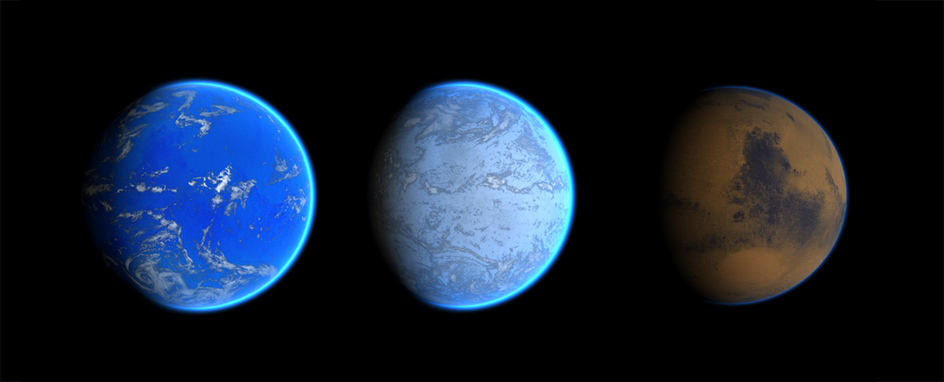
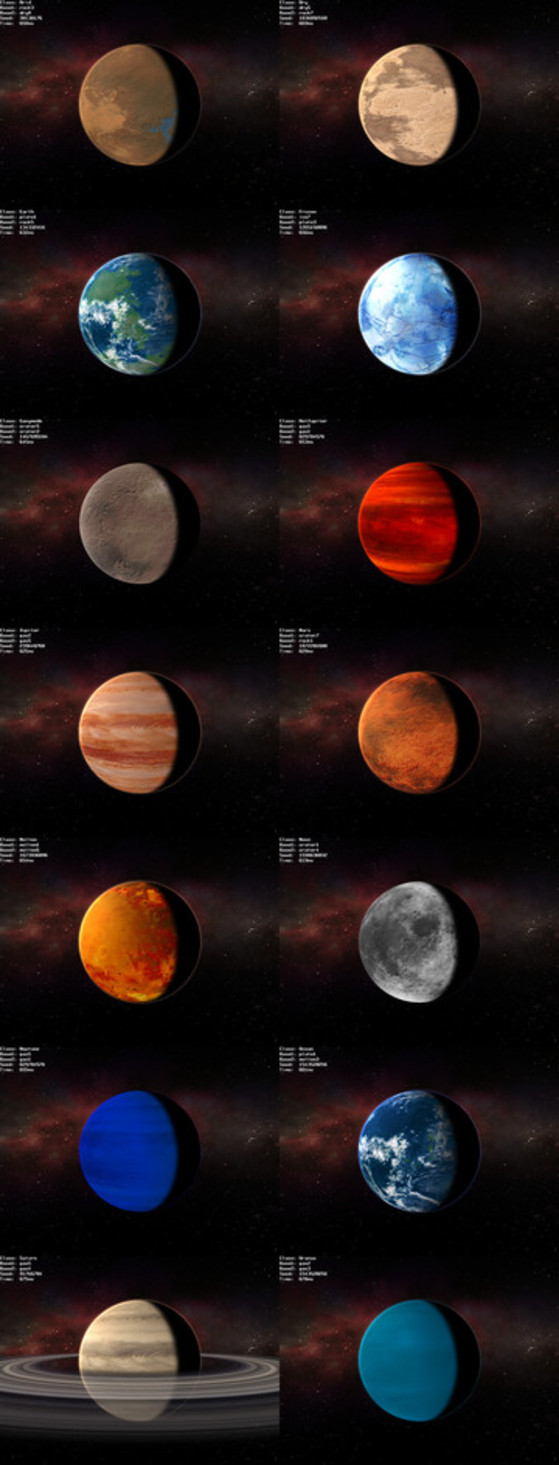
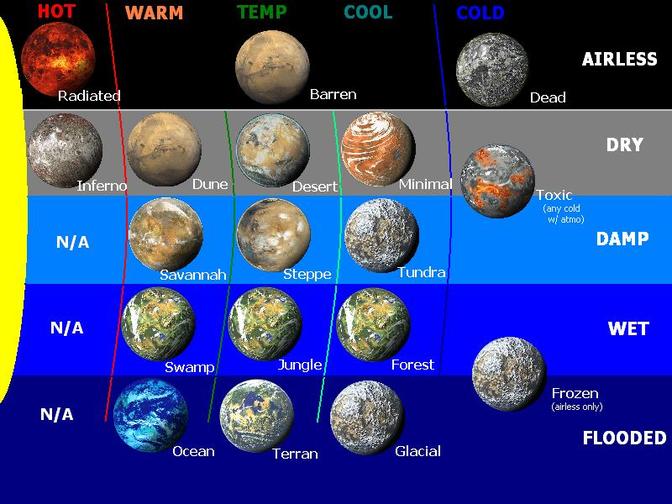
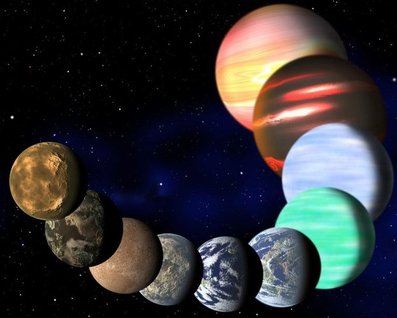
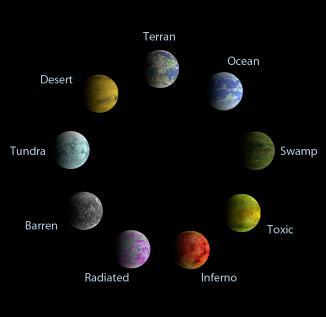
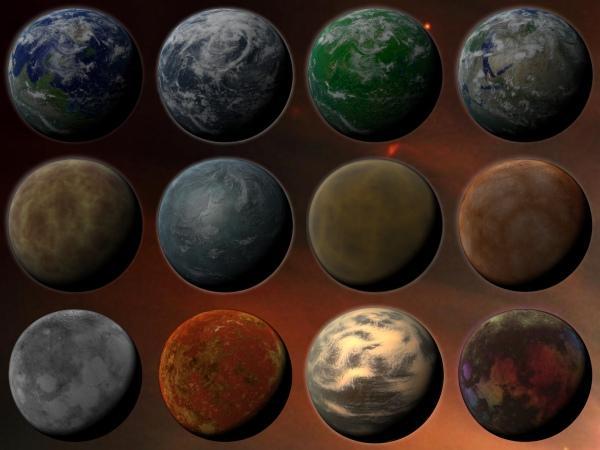

World Data Sheet
(example only)
The New Planet Classification System:
The Star Fleet system for classifying planets was visionary, groundbreaking, and quite thorough in its time, and it was used for many years with significant success. However, the Star Fleet system was over-simplified in some ways, convoluted in others; at the time, it was not possible to envision to full scope of the worlds which would be found; which would have to be further understood and categorized, and it made the mistake of grouping sets of planet characteristics into commonly occurring sequences. This made the system inflexible when dealing with unique worlds which did not have all of the characteristics of one of that system's classes. The only solution at the time, prior to the idea of rethinking the entire system, was to assign multiple letters (multiple classes) to worlds with unexpected combinations of characteristics, and even then... that after-thought work-around approach still left the problems of its classes giving users the wrong idea about which characteristics those unique planets had. For example, if a world which could not be labeled as a Class M or Class J was labeled as Class M/J, upon first reading that... it was logical for the user of this system to assume that meant the world in question had all of the characteristics of Class M and Class J worlds, when the world might only have had one or two of each, or all of one class and only one characteristic of the other class. A revision to this system, therefore, was clearly needed.
The Inisfreeans instead use this system: Instead of just one letter indicating the overall type of a planet, many of which did not end up having the same set of characteristics the Star Fleet planet classes had to have to be labeled with those single-letter classifications, Inisfreeans use a group of letters and numbers in the following sequence:
Letters remaining: VWXYZ
Component Examples:
Inisfreean Planet Classification Examples:
The Star Fleet system for classifying planets was visionary, groundbreaking, and quite thorough in its time, and it was used for many years with significant success. However, the Star Fleet system was over-simplified in some ways, convoluted in others; at the time, it was not possible to envision to full scope of the worlds which would be found; which would have to be further understood and categorized, and it made the mistake of grouping sets of planet characteristics into commonly occurring sequences. This made the system inflexible when dealing with unique worlds which did not have all of the characteristics of one of that system's classes. The only solution at the time, prior to the idea of rethinking the entire system, was to assign multiple letters (multiple classes) to worlds with unexpected combinations of characteristics, and even then... that after-thought work-around approach still left the problems of its classes giving users the wrong idea about which characteristics those unique planets had. For example, if a world which could not be labeled as a Class M or Class J was labeled as Class M/J, upon first reading that... it was logical for the user of this system to assume that meant the world in question had all of the characteristics of Class M and Class J worlds, when the world might only have had one or two of each, or all of one class and only one characteristic of the other class. A revision to this system, therefore, was clearly needed.
The Inisfreeans instead use this system: Instead of just one letter indicating the overall type of a planet, many of which did not end up having the same set of characteristics the Star Fleet planet classes had to have to be labeled with those single-letter classifications, Inisfreeans use a group of letters and numbers in the following sequence:
- Placement/position in P (represented by 'P'), as a fraction; the number this planet is out of all the planets orbiting its star
- Distance in AU: Astronomical Units; how far the planet is from the main/only star of its solar system
- Size in E (for Earth volume) for terrestrial worlds, or J (for standard gas-giant ('Jovian' as in Jove; ancient name for Jupiter) volume; 1 Jupiter) for gas worlds; J.05 = Neptune's mass; 5% of Jupiter's, while J1 = Jupiter's mass, and another above J13 begins fusion, making the hyper-giant become a brown dwarf. (*The Sun would be J1000, as it is 1,000x more massive than Jupiter, and Earth would be J.00315, while Jupiter would be E317.83.)
- Age in BYO (Billions of Years Old), with the range being from BYO13.8 to BYO.0001 (which = 100,000 years old)
- Atmosphere (air pressure / atmospheric pressure / barometric pressure) in A, ranging from 0-7; 0 = none (Mercury has almost 0 atm), 1 = thinnest, 2 = thinner, 3 = thin, 4 = Earth average (1.0 atm), 5 = thick, 6 = thicker; gas-giants (8-12 atm), 7 = thickest; hyper-giants and stars (12+ atm)
- Surface in S, ranging from 0-7; 0 = unknowable surface (such as the shifting gas-giants' outermost layers), 1 = forming surface (unstable, dynamic, changing), 2 = molten surface (formed but still fluid, lava waves like an ocean's), 3 = volcanic surface (frequent and dramatic tectonic activity; routine major earthquakes), 3 = tectonically active (earthquakes more common and intense than those of Earth), 4 = standard Earth tectonics (usually infrequent and minor, with occasional major ones), 5 = decreasing/minimal/infrequent/negligible tectonics, 6 = geo-inactive (but was once active to some degree), 7 = has never been tectonically active
- Crust thickness in CT, ranging from 0-7; 0 = none (mantle exposed because crust is still molten), 1 = thinnest (barely >0% of the world's diameter --Earth's crust thickness is .05% of its diameter; ~400 miles thick), 2 = thinner (.1-.5% of the diameter), 3 = thin (.5-1% of the diameter), 4 = intermediate (1-2% of the diameter, such as is the case with Mars), 5 = thick (2-5% of the diameter, such as is the case with the Moon), 6 = thicker (5-10% of the diameter), 7 = thickest (10-99% of the diameter)
- Core in C, ranging from 0-7; 0 = hollow core, 1 = plasma core, 2 = gas core, 3 = vapor core, 4 = liquid core, 5 = fluid core (such as magma; molten rock), 6 = solid core (no spin, and little to no other movement)
- Gravity in G, ranging from 0-7; 0 = none, 1 = lowest; negligible; almost none (disorienting and dangerous for most Earth life; asteroids and planetessimals (*Mars' moons; Phobos and Deimos, are 0.0005814 and 0.000306 respectively)), 2 = lower; osteoporosis risk for most vertebrate Earth life (.05-.3G; dwarf planets, normal moons, and planetoids (*Moon is .165G, Pluto is .067G)), 3 = low; fun for most Earth life (.3-1G; small planets such as Mercury and Mars), 4 = Earth's (1G (*Venus is .91G)), 5 = high; taxing to most Earth life (~1-3G; gas-giants), 6 = higher; painful to most Earth life (~4-10G; non-Repulsine pilots experience these), 7 = highest; crushing to most Earth life (>10G; stars (Sun = 27.94G on its surface, and neutron stars are up to ~1,000,000,000,000G))
- Orbit (revolution about the star) Eccentricity in OE, ranging from 0-7; 0 = none; drifting/unknown, 1 = decaying (eccentricity is <0), 2 = circular (eccentricity = 0), 3 = elliptical (eccentricity is >0 but <1), 4 = parabolic (eccentricity = 1), 5 = hyperbolic (eccentricity is >1), 6 = so vast its path appears linear, 7 = shared/transitional
- Orbit Inclination (above or below the solar plane) in OI, ranging from 0-7; 0 = none/unknown, 1 = extreme pitch (179° to 120°), 2 = intermediate pitch (120° to 60°), 3 = slight pitch (60°-1°), 4 = 0° (equatorial plane), 5 = slight roll (1° to 60°), 6 = intermediate roll (60° to 120°), 7 = extreme roll (120° to 179°) (*'low' and 'high', 'lower' and 'higher', and 'lowest and highest' would not make sense with this planet descriptor due to the nature of the orbit; passing through both the negative and positive hemispheres around the reference plane)
- Rotation in R, ranging from 0-7; 0 = none; tidally locked, 1 = slowest; 1 rotation (day-night cycle) takes longer than this world's year; equatorial days here take longer than this world's year, 2 = slower; equatorial days take longer than an Earth-standard month (28 days) or longer than 1/13 of this world's year, 3 = slow; equatorial days take slightly >24 hours to slightly longer than an Earth-standard week (7 days) or 1/52 of this world's year, 4 = equatorial days are close to the Earth-standard; 1 rotation (day-night cycle) per 24 hours, 5 = fast; equatorial days take less than the Earth-standard (<24 hours) but more than 1 hour, 6 = faster; equatorial days take less than the Earth-standard hour but more than 1 minute, 7 = fastest; equatorial days take less than the Earth-standard minute (gravity on the inner surface of a hollow world rotating at this speed would be crushing, while attempts to land on the outer surface could result in being launched back into Space)
- Axial Tilt in AT, ranging from 0-7; 0 = none, 1 = 0-30° (Jupiter is 3.3°, Moon is 6.68°, Earth is 23.4°, Mars is 25.19°, Saturn is 26.73°, Neptune is 28.32°), 2 = 30-60°, 3 = 60-90°, 4 = 90-120° (Uranus is 97°, making it rotate sideways relative all other planets in the Sun solar system), 5 = 120-150° (Pluto is 122.53°), 6 = 150-180°, 7 = 180° (Venus is 177.36°, making it rotate backward relative all other planets in the Sun solar system)
- Day-night cycle in D, ranging from 0-7; 0 = none; tidally locked, 1 = always obscured (100% of the time; days per year (*Venus is a prime example.)), 2 = often obscured (99%-80% of the time), 3 = sometimes/routinely obscured (80%-60% of the time), 4 = Earth-standard; 2 equinoxes and 2 solstices with occasional/seasonal inclement weather obscuring exact time of day (60%-40% of the time, depending on region and season (*Colombia, Scotland, Seattle, Venezuela, and southeast Asia during monsoon season are usually at 60%, while the Sahara and most other places are closer to 40%, and the Dry Valleys being a fluke at 0%)), 5 = infrequently but not rarely --and not necessarily seasonally (40%-20% of the time), 6 = rarely obscured (20%-1% of the time (*Mars is an example.)), 7 = never obscured (0% of the time (*Mercury and Pluto are examples.))
- Elements of the Periodic Table (in the crust) in EPT, ranging from 0-11; 0 = no known elements, 1 = predominantly unknown elements, 2 = predominantly Alkali metals, 3 = predominantly Alkaline earth metals, 4 = predominantly Lanthanoids, 5 = predominantly Actinoids, 6 = predominantly Transition metals, 7 = predominantly Post-transition metals, 8 = predominantly metalloids, 9 = predominantly 'other nonmetals' (H, C, N, O, P, S, and/or Se), 10 = predominantly halogens, 11 = predominantly noble gases (more info' about these elements, such as at which temperature each one enters a new state (e.g. solid, liquid, gas), navigate to this website: http://www.ptable.com/)
- Surface Temperature in ST, ranging from 0-7; 0 = coldest (inter-stellar medium temperature; the temperature of Deep Space; ~-455°F, to ice dwarf temperature; -350°F (*Pluto = -396.67°F, )), 1 = colder; -350°F to -250°F, 2 = cold; -250°F to -150°F (*Mars = -128.47°F (night) to -24.07 (day)), 3 = average; cool to warm (*Earth = -128.6°F (coldest night near South Pole) to 134°F (hottest day in Death Valley)), 4 = hot; 150-500°F, 5 = hotter; 500-1,200°F --such as 'green-house worlds' (*Mercury = -279.67°F (night) to 845.33°F (day), and Venus = 866.93°F, at which point Zinc, Tin, and Lead are melted)), 6 = hottest terrestrial; fluid surface; lava; highly volcanic (~1,200+°F), 7 = hottest gas-giant to ultra-giant temperatures (~-230°F in the clouds, and ~45,000-65,000°F at the core, meaning even Carbon would melt before reaching the core (*Uranus = -371.2°F (upper cloud level) to ~8,540°F (at the core), Neptune = -330.07°F (upper cloud level) to ~9,260°F (at the core), Saturn = -218.47°F (upper cloud level) to ~21,000°F (at the core), Jupiter = -234°F (upper cloud level) to ~64,000°F (at the core), and ~100,000,000°C; 180,000,032°F is the threshold of fusion which would turn a hyper-giant into a dwarf star))
- Surface Albedo (radiation) in SA, ranging from 0-7; 0 = none; radiation-blasted surface like nuclear fallout, 1 = lowest; radiation sickness risk (~.01-.1 (*Ceres = .090)), 2 = lower; serious skin cancer risk (~.1-.2 (*Mercury = .106, Moon = .12)), 3 = low; severe sunburn risk (~.2-.3; common (*Mars = .25)), 4 = Earth-standard (~.3-.4, because a magnetosphere helps deflect much of the solar radiation), 5 = high (~.4-.5 (*Neptune = .41, Saturn = .47)), 6 = higher (~.5-.6 (*Uranus = .51, Jupiter = .52)), 7 = highest (~.6-1.0 (*Venus = .65, Europa = .67, Eris = .96, Enceladus = .99, and Pluto ranges from .49 to .66 depending on where it is along its orbit))
- Surface coverage by Liquid (not necessarily water) in SL, ranging from 0-7; 0 = none (not even ponds), 1 = 1-15% (streams and ponds), 2 = 15-30% (creeks and lakes), 3 = 30-45% (small rivers and bays), 4 = 45-60% (medium-sized rivers and gulfs), 5 = 60-75% (large rivers and seas (*Earth is 71%)), 6 = 75-90% (oceans), 7 = 90-100% (ocean world)
- Climates in K, ranging from 0-12; 0 = new/unknown, 1 = hottest/driest (Arid), 2 = hotter/drier (Semi-arid), 3 = hot/dry (Mediterranean), 4 = hot and sometimes dry, sometimes wet (Tropical Wet and Dry), 5 = hot and wet (Tropical Wet), 6 = warmer (Humid Subtropical), 7 = warm (Humid Continental), 8 = cool (Marine West Coast), 9 = cold (Subarctic/Boreal), 10 = colder (Tundra), 11 = highest so usually also colder to coldest (Highland), 12 = coldest so usually also dry (Icecap)
- Biomes in B, ranging from 0-29; 0 = new/unknown, 1 = tropical rainforest (and jungle, though jungles are slightly drier), 2 = tropical and subtropical moist broadleaf forests, 3 = tropical and subtropical dry broadleaf forests, 4 = tropical and subtropical coniferous forests, 5 = tropical and subtropical grassland/savanna and shrubland, 6 = subtropical rainforest, 7 = subtropical dry forest, 8 = temperate broadleaf and mixed forests, 9 = temperate coniferous forest, 10 = temperate steppe, 11 = dry steppe, 12 = semiarid desert, 13 = arid desert; barren (sand and/or ice), 14 = xeric shrubland, 15 = temperate grassland/savanna, 16 = flooded grassland/savanna; marsh/wetland/swamp, 17 = tree savanna, 18 = Mediterranean forest, woodland, and scrub/sclerophyll forest, 19 = monsoon forest, 20 = mangrove (tidal swamp), 21 = alpine/montane grassland and shrubland, 22 = alpine/montane forest, 23 = alpine/montane tundra, 24 = taiga/boreal forest, 25 = tundra, 26 = ice sheet and polar desert (glacial), 27 = aquatic (freshwater; 13 subtypes), 28 = marine (saltwater/sea/ocean; 3 subtypes: coastal, continental shelf, deep sea), 29 = endolithic (deep cave/crust)
- Life in L, ranging from 0-7; 0 = none, 1 = predominantly primitive; microscopic/single-cellular, 2 = predominantly primitive; microscopic/multi-cellular, 3 = predominantly plants, 4 = invertebrates present, 5 = vertebrates present, 6 = technologically capable (though not yet Space-faring, etc.) life of some sort or various sorts, 7 = technologically advanced (Space-faring, etc.) life of some sort or various sorts
- Intelligence Quotient (including Emotional Intelligence Quotient; EQ a.k.a. EI) in Q, ranging from 0-7; 0 = none (extinct --or N/A due to no comparable brains), 1 = IQ of 40-70 (mentally retarded), 2 = IQ of 70-85 (below average human intelligence), 3 = IQ of 85-115 (average human intelligence), 4 = IQ of 115-130 (above average human intelligence), 5 = IQ of 130-145 (high human intelligence), 6 = IQ of 145-175 (very high (to highest known) human intelligence), 7 = IQ of 175+; unmeasured/immeasurable (relative to humans)
- Military (service) in M, ranging from 0-7; 0 = none, 1 = stand-by reserves (some are activated for emergencies), 2 = small standing (<1% of the population is on active duty), 3 = average standing (~1% of the population is on active duty), 4 = medium-size standing (2-25%, 5 = large standing (25-90% of the population is on active duty), 6 = total part-time (100% serve for a portion of their lives), 7 = total lifelong (100% serve for life)
- Space Navy (range) in N, ranging from 0-7; 0 = none (may have a Space program in its fledgling stage, but no way to defend it beyond the atmosphere), 1 = surface to orbit (relatively primitive interceptor aerospacecraft such as the B-3 Aurora, or long-range lasers mounted on observatories or aircraft nose-cones), 2 = inter-planetary (usually involving sub-light (below light-speed) travel, such as via hyper-drives), 3 = out to the homeworld's solar system's Kuiper Belt equivalent (usually involving relative-FTL travel, such as via warp-drives), 4 = out to the homeworld's solar system's Oort Cloud equivalent (usually involving relative-FTL travel, such as warp-surfing), 5 = beyond the inter-stellar medium; inter-stellar (usually involving relative-FTL travel, such as Mass Relays (which instantly connect to each other)), 6 = beyond the inter-galactic medium; inter-galactic (usually involving relative-FTL travel, such as Star-gates), 7 = beyond the inter-universal medium; inter-dimensional (usually involving phase-shifting, such as to access the Webway)
- Formidability (relative Inisfree) in F, ranging from 0-7; 0 = negligible (pre-nuclear technology), 1 = potential or active annoyance (such as via nuclear to thermonuclear weaponry), 2 = potential average threat (such as via the ongoing development of/toward photon weaponry; more powerful than thermonuclear bombs but less powerful than black-hole/nova devices), 3 = active average threat (such as via photon weaponry; more powerful than thermonuclear bombs but less powerful than black-hole/nova devices), 4 = potential major threat (such as via the ongoing development of/toward stellar weaponry, such as black-hole/nova devices), 5 = active major threat (such as via stellar weaponry, such as black-hole/nova devices), 6 = potential severe threat (such as via the ongoing development of/toward Temporis or omni-interfacing technology), 7 = active severe threat (such as via Temporis or omni-interfacing technology) (*Inisfreeans, Inisfree, and all Inisfreean constructs are invincible, however the Outlander things we enjoy are always at some degree of risk, so the threat to us is indirect; based on whether or not it hinders our desired interaction with compatible Outlanders.)
- Libido of indigenous humanoids in H (for horniness), ranging from 0-7; 0 = none (asexual; not just asexual reproduction or no reproduction; no sex or sex-like activity), 1 = lowest; infrequent even across a decade, 2 = lower; annually, 3 = low; monthly, 4 = average (Earth-human standard; weekly if possible), 5 = high (Inisfree-standard; daily to hourly), 6 = higher than Inisfree-standard (more than several times per hour), 7 = highest; extreme (nymphomaniacal; ~constant to constant; to the point of being annoying to Inisfreeans)
- Compatibility (with Inisfreeans / the Inisfreean Way) in I, ranging from 0-7; 0 = not at all (and potentially diametrically opposed; polar opposites likely to become hostile indefinitely), 1 = lowest (able to interact civilly under supervision and from a distance, such as through radio transmissions), 2 = lower (able to interact civilly via teleconferences), 3 = low; slightly below average (able to interact civilly via 5-senses transmissions; like TV with smells, tastes, and feelings added); , 4 = average (able to interact as platonic friends via 5-senses transmissions; like TV with smells, tastes, and feelings added), 5 = high; above average (able to interact as platonic friends in-person in compatible Outlands realms); , 6 = higher; mostly (able to interact as fuck-buddies in compatible Outlands realms); , 7 = highest; fully (possibly already interacting with Inisfreeans on perfectly mutually agreeable terms even in the Inisfreean realm, such as Inisfree's ships, Inisfree, or Star-system Auzdein)
Letters remaining: VWXYZ
Component Examples:
- P3/9 = the planet is the 3rd out from its star, its solar system having 9 planets
- AU1 = the planet is 1 AU from its star; the same distance Earth is from the Sun
- E1 = the planet is the same volume (and likely the same diameter) as the Earth
- BYO4.5 = 4,500,000,000 years old; the same age as most of the worlds in the Sun solar system
- A4 = comparable to Earth's atmospheric pressure
Inisfreean Planet Classification Examples:
- Earth: P3/9|AU1|E1|BYO4.54|A4|S4|CT1|C5|G4|OE_|OI_|R_|AT_|D_|EPT_|ST_|SA_|SL5|K1-9|B1-29|L_|Q_|M_|N_|F_|H4|I_
- Jupiter: P5/9|AU5.2|J1|BYO4.5|A_|S0|CT_|C_|G_|OE_|OI_|R_|AT_|D_|EPT_|ST_|SA_|SL0|K_|B_|L_|Q_|M_|N_|F_|H_|I_
- SunAU1E1BYO4.54A4S4C5G4OEOIRATDEPT...
